Business Functions
VerifiedAdded on 2023/01/04
|24
|5710
|42
AI Summary
This document provides an overview of various business functions such as human resource management, motivation, retention, training, marketing, and technology in business. It discusses the importance of these functions in organizations and provides insights into their implementation. The document also includes a case study on Silver Fern Farms Limited, a multinational company from New Zealand. Study material and solved assignments on business functions are available at Desklib.
Contribute Materials
Your contribution can guide someone’s learning journey. Share your
documents today.

1 | P a g e
Business Functions
Name Date Name of the File
Business Functions
Name Date Name of the File
Secure Best Marks with AI Grader
Need help grading? Try our AI Grader for instant feedback on your assignments.
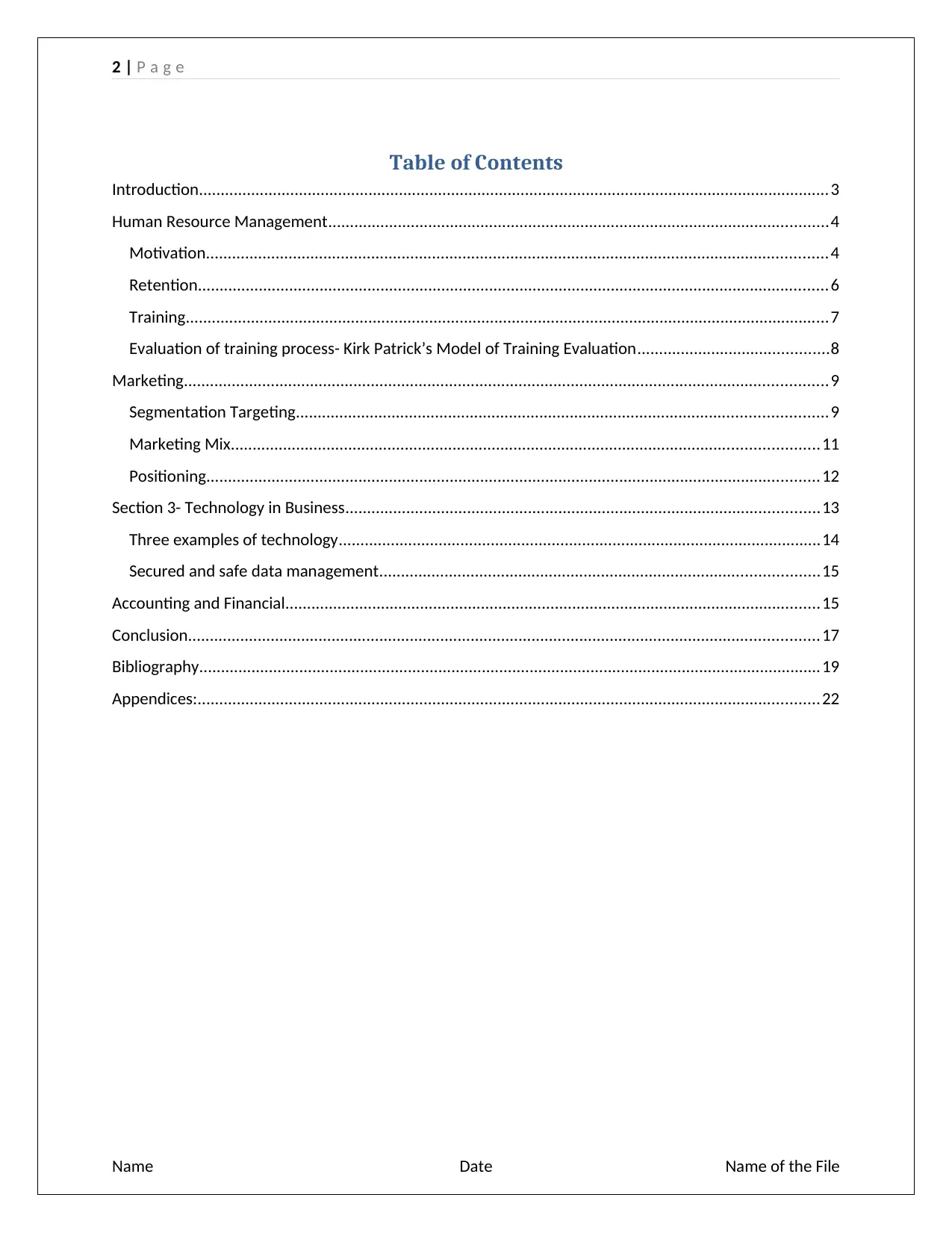
2 | P a g e
Table of Contents
Introduction.................................................................................................................................................3
Human Resource Management...................................................................................................................4
Motivation...............................................................................................................................................4
Retention.................................................................................................................................................6
Training....................................................................................................................................................7
Evaluation of training process- Kirk Patrick’s Model of Training Evaluation............................................8
Marketing....................................................................................................................................................9
Segmentation Targeting..........................................................................................................................9
Marketing Mix.......................................................................................................................................11
Positioning.............................................................................................................................................12
Section 3- Technology in Business.............................................................................................................13
Three examples of technology...............................................................................................................14
Secured and safe data management.....................................................................................................15
Accounting and Financial...........................................................................................................................15
Conclusion.................................................................................................................................................17
Bibliography...............................................................................................................................................19
Appendices:...............................................................................................................................................22
Name Date Name of the File
Table of Contents
Introduction.................................................................................................................................................3
Human Resource Management...................................................................................................................4
Motivation...............................................................................................................................................4
Retention.................................................................................................................................................6
Training....................................................................................................................................................7
Evaluation of training process- Kirk Patrick’s Model of Training Evaluation............................................8
Marketing....................................................................................................................................................9
Segmentation Targeting..........................................................................................................................9
Marketing Mix.......................................................................................................................................11
Positioning.............................................................................................................................................12
Section 3- Technology in Business.............................................................................................................13
Three examples of technology...............................................................................................................14
Secured and safe data management.....................................................................................................15
Accounting and Financial...........................................................................................................................15
Conclusion.................................................................................................................................................17
Bibliography...............................................................................................................................................19
Appendices:...............................................................................................................................................22
Name Date Name of the File
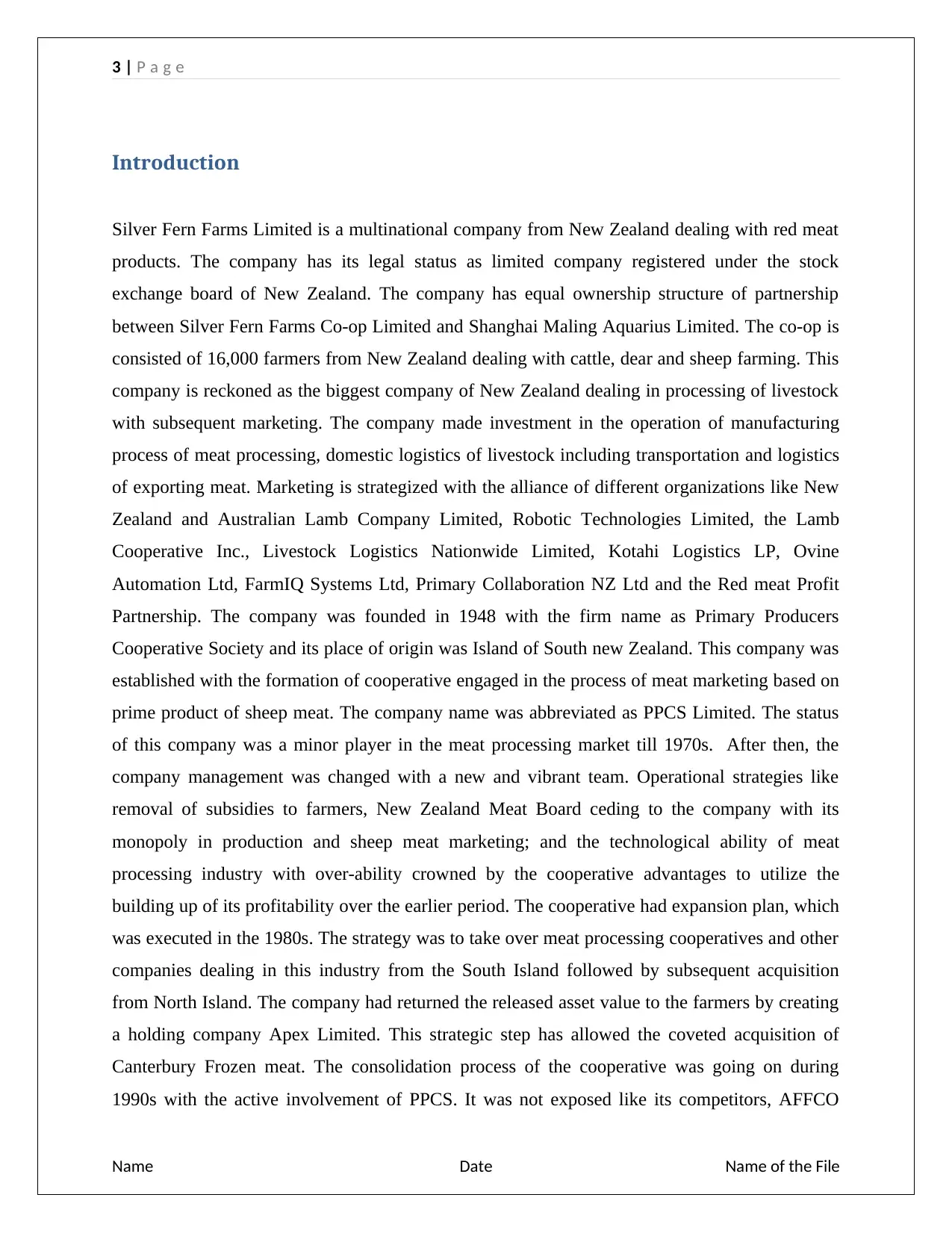
3 | P a g e
Introduction
Silver Fern Farms Limited is a multinational company from New Zealand dealing with red meat
products. The company has its legal status as limited company registered under the stock
exchange board of New Zealand. The company has equal ownership structure of partnership
between Silver Fern Farms Co-op Limited and Shanghai Maling Aquarius Limited. The co-op is
consisted of 16,000 farmers from New Zealand dealing with cattle, dear and sheep farming. This
company is reckoned as the biggest company of New Zealand dealing in processing of livestock
with subsequent marketing. The company made investment in the operation of manufacturing
process of meat processing, domestic logistics of livestock including transportation and logistics
of exporting meat. Marketing is strategized with the alliance of different organizations like New
Zealand and Australian Lamb Company Limited, Robotic Technologies Limited, the Lamb
Cooperative Inc., Livestock Logistics Nationwide Limited, Kotahi Logistics LP, Ovine
Automation Ltd, FarmIQ Systems Ltd, Primary Collaboration NZ Ltd and the Red meat Profit
Partnership. The company was founded in 1948 with the firm name as Primary Producers
Cooperative Society and its place of origin was Island of South new Zealand. This company was
established with the formation of cooperative engaged in the process of meat marketing based on
prime product of sheep meat. The company name was abbreviated as PPCS Limited. The status
of this company was a minor player in the meat processing market till 1970s. After then, the
company management was changed with a new and vibrant team. Operational strategies like
removal of subsidies to farmers, New Zealand Meat Board ceding to the company with its
monopoly in production and sheep meat marketing; and the technological ability of meat
processing industry with over-ability crowned by the cooperative advantages to utilize the
building up of its profitability over the earlier period. The cooperative had expansion plan, which
was executed in the 1980s. The strategy was to take over meat processing cooperatives and other
companies dealing in this industry from the South Island followed by subsequent acquisition
from North Island. The company had returned the released asset value to the farmers by creating
a holding company Apex Limited. This strategic step has allowed the coveted acquisition of
Canterbury Frozen meat. The consolidation process of the cooperative was going on during
1990s with the active involvement of PPCS. It was not exposed like its competitors, AFFCO
Name Date Name of the File
Introduction
Silver Fern Farms Limited is a multinational company from New Zealand dealing with red meat
products. The company has its legal status as limited company registered under the stock
exchange board of New Zealand. The company has equal ownership structure of partnership
between Silver Fern Farms Co-op Limited and Shanghai Maling Aquarius Limited. The co-op is
consisted of 16,000 farmers from New Zealand dealing with cattle, dear and sheep farming. This
company is reckoned as the biggest company of New Zealand dealing in processing of livestock
with subsequent marketing. The company made investment in the operation of manufacturing
process of meat processing, domestic logistics of livestock including transportation and logistics
of exporting meat. Marketing is strategized with the alliance of different organizations like New
Zealand and Australian Lamb Company Limited, Robotic Technologies Limited, the Lamb
Cooperative Inc., Livestock Logistics Nationwide Limited, Kotahi Logistics LP, Ovine
Automation Ltd, FarmIQ Systems Ltd, Primary Collaboration NZ Ltd and the Red meat Profit
Partnership. The company was founded in 1948 with the firm name as Primary Producers
Cooperative Society and its place of origin was Island of South new Zealand. This company was
established with the formation of cooperative engaged in the process of meat marketing based on
prime product of sheep meat. The company name was abbreviated as PPCS Limited. The status
of this company was a minor player in the meat processing market till 1970s. After then, the
company management was changed with a new and vibrant team. Operational strategies like
removal of subsidies to farmers, New Zealand Meat Board ceding to the company with its
monopoly in production and sheep meat marketing; and the technological ability of meat
processing industry with over-ability crowned by the cooperative advantages to utilize the
building up of its profitability over the earlier period. The cooperative had expansion plan, which
was executed in the 1980s. The strategy was to take over meat processing cooperatives and other
companies dealing in this industry from the South Island followed by subsequent acquisition
from North Island. The company had returned the released asset value to the farmers by creating
a holding company Apex Limited. This strategic step has allowed the coveted acquisition of
Canterbury Frozen meat. The consolidation process of the cooperative was going on during
1990s with the active involvement of PPCS. It was not exposed like its competitors, AFFCO
Name Date Name of the File
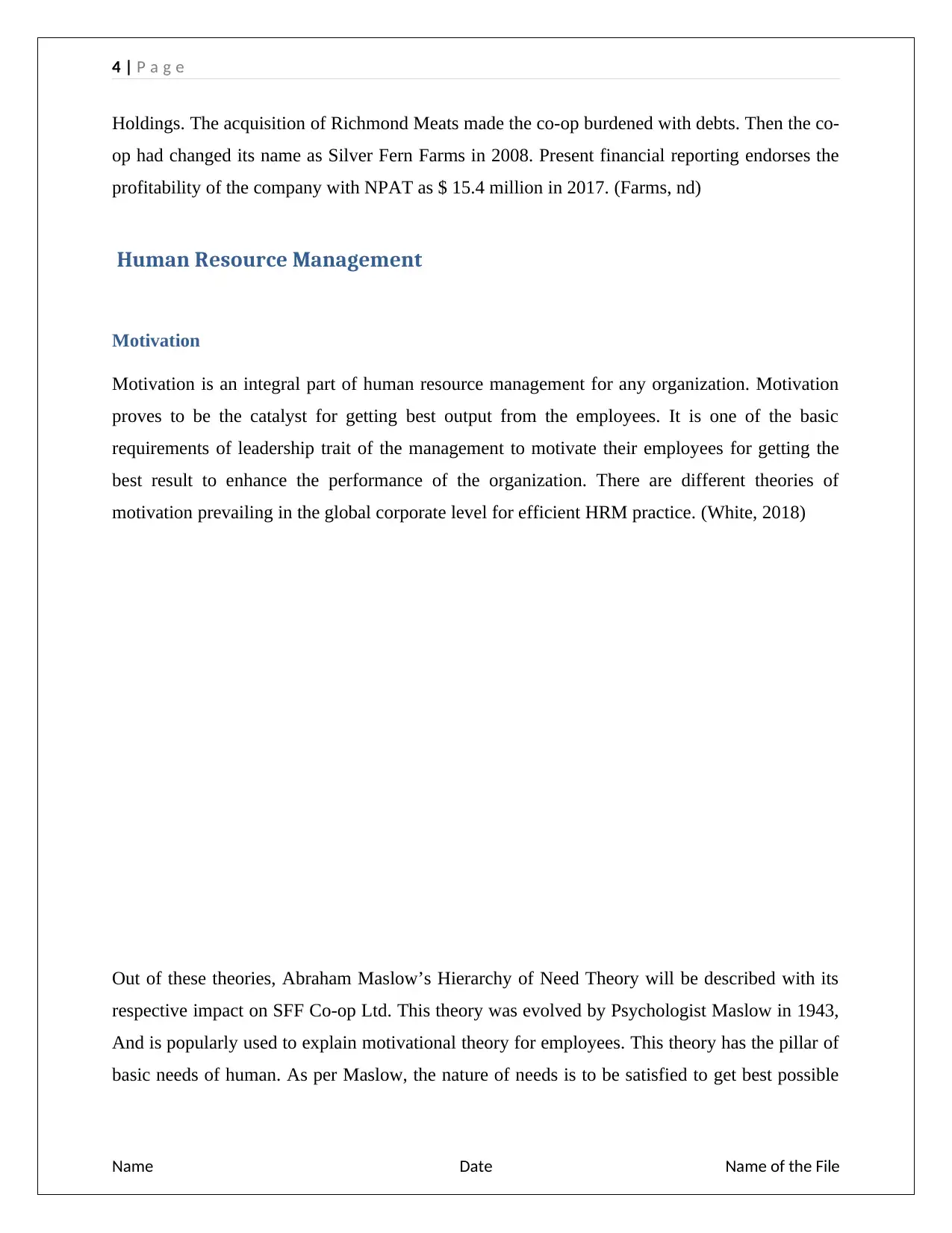
4 | P a g e
Holdings. The acquisition of Richmond Meats made the co-op burdened with debts. Then the co-
op had changed its name as Silver Fern Farms in 2008. Present financial reporting endorses the
profitability of the company with NPAT as $ 15.4 million in 2017. (Farms, nd)
Human Resource Management
Motivation
Motivation is an integral part of human resource management for any organization. Motivation
proves to be the catalyst for getting best output from the employees. It is one of the basic
requirements of leadership trait of the management to motivate their employees for getting the
best result to enhance the performance of the organization. There are different theories of
motivation prevailing in the global corporate level for efficient HRM practice. (White, 2018)
Out of these theories, Abraham Maslow’s Hierarchy of Need Theory will be described with its
respective impact on SFF Co-op Ltd. This theory was evolved by Psychologist Maslow in 1943,
And is popularly used to explain motivational theory for employees. This theory has the pillar of
basic needs of human. As per Maslow, the nature of needs is to be satisfied to get best possible
Name Date Name of the File
Holdings. The acquisition of Richmond Meats made the co-op burdened with debts. Then the co-
op had changed its name as Silver Fern Farms in 2008. Present financial reporting endorses the
profitability of the company with NPAT as $ 15.4 million in 2017. (Farms, nd)
Human Resource Management
Motivation
Motivation is an integral part of human resource management for any organization. Motivation
proves to be the catalyst for getting best output from the employees. It is one of the basic
requirements of leadership trait of the management to motivate their employees for getting the
best result to enhance the performance of the organization. There are different theories of
motivation prevailing in the global corporate level for efficient HRM practice. (White, 2018)
Out of these theories, Abraham Maslow’s Hierarchy of Need Theory will be described with its
respective impact on SFF Co-op Ltd. This theory was evolved by Psychologist Maslow in 1943,
And is popularly used to explain motivational theory for employees. This theory has the pillar of
basic needs of human. As per Maslow, the nature of needs is to be satisfied to get best possible
Name Date Name of the File
Secure Best Marks with AI Grader
Need help grading? Try our AI Grader for instant feedback on your assignments.
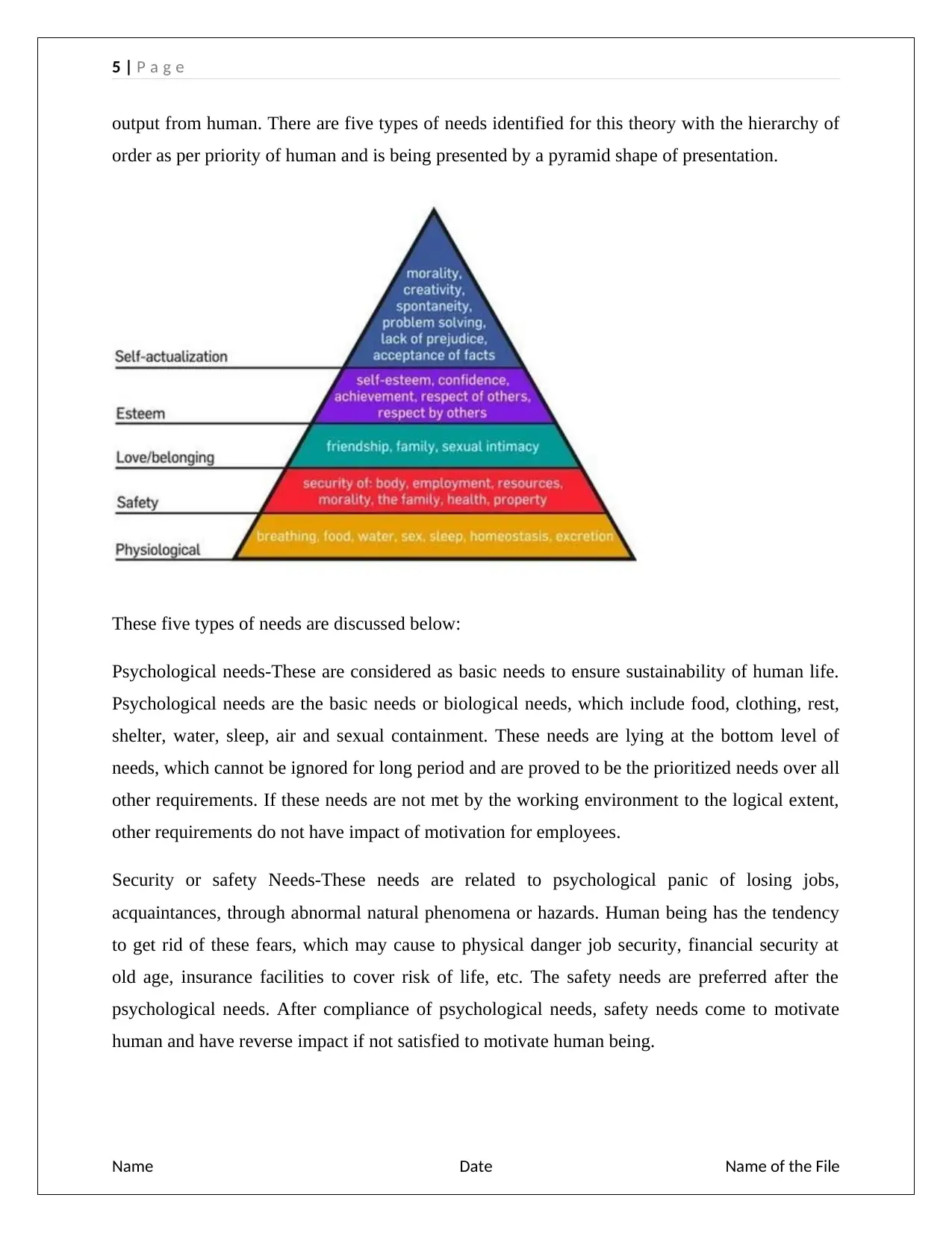
5 | P a g e
output from human. There are five types of needs identified for this theory with the hierarchy of
order as per priority of human and is being presented by a pyramid shape of presentation.
These five types of needs are discussed below:
Psychological needs-These are considered as basic needs to ensure sustainability of human life.
Psychological needs are the basic needs or biological needs, which include food, clothing, rest,
shelter, water, sleep, air and sexual containment. These needs are lying at the bottom level of
needs, which cannot be ignored for long period and are proved to be the prioritized needs over all
other requirements. If these needs are not met by the working environment to the logical extent,
other requirements do not have impact of motivation for employees.
Security or safety Needs-These needs are related to psychological panic of losing jobs,
acquaintances, through abnormal natural phenomena or hazards. Human being has the tendency
to get rid of these fears, which may cause to physical danger job security, financial security at
old age, insurance facilities to cover risk of life, etc. The safety needs are preferred after the
psychological needs. After compliance of psychological needs, safety needs come to motivate
human and have reverse impact if not satisfied to motivate human being.
Name Date Name of the File
output from human. There are five types of needs identified for this theory with the hierarchy of
order as per priority of human and is being presented by a pyramid shape of presentation.
These five types of needs are discussed below:
Psychological needs-These are considered as basic needs to ensure sustainability of human life.
Psychological needs are the basic needs or biological needs, which include food, clothing, rest,
shelter, water, sleep, air and sexual containment. These needs are lying at the bottom level of
needs, which cannot be ignored for long period and are proved to be the prioritized needs over all
other requirements. If these needs are not met by the working environment to the logical extent,
other requirements do not have impact of motivation for employees.
Security or safety Needs-These needs are related to psychological panic of losing jobs,
acquaintances, through abnormal natural phenomena or hazards. Human being has the tendency
to get rid of these fears, which may cause to physical danger job security, financial security at
old age, insurance facilities to cover risk of life, etc. The safety needs are preferred after the
psychological needs. After compliance of psychological needs, safety needs come to motivate
human and have reverse impact if not satisfied to motivate human being.
Name Date Name of the File

6 | P a g e
Social Needs-Human being is social inhabitant and needs to enjoy living in a group. This feeling
is motivated by the feeling of membership of any group with perpetual acceptance from group
members. This basic need also demands to be loved by other persons with the concept of
friendship followed by interactions with friends, colleagues and superiors.
Esteem needs-These needs demand respect from others with acknowledgement, power and
ultimate destination of prestigious position. These needs come when the previous three needs are
satisfied. Esteem needs promote the feelings of self-confidence, competence, self-respect, etc.
These needs can be met by organization of attachment form the viewpoint of employment or
other social activities through recognition. As per Obert Tanner, recognition can make the
business run smoother through its own role.
Self-actualization Needs- These needs are placed on the top of the needs, as specified by
Maslow. This needs originate from the feeling of self awareness to fix destination and the ability
to reach that destination through owned developed skills. This need is known as growth need.
Each individual has the dream to accomplish life objectives with the ability gained through
skills. This need promotes the sense of facing challenges in professional life to prove ability of
individual. It is often observed that the hardest hurdle to cross and not many individual can
accomplish this objective. (Jahan, nd)
Retention
In Maslow’s theory of Motivation, the needs of esteem and self-actualization are main factors for
retention of employees. (Ramlall, 2004) SFF has to prioritize retention of specific class of
employees out of lower, middle and high levels of employees. If they want to retain high level of
employees in the form of decision makers, they have to fix certain objectives for those
employees with specific quantitative and qualitative parameter of accomplishments of those
objectives. The needs of esteem and self-actualization can be met through different activities, out
of which, setting goals and appraise the performance can be good option for SFF for its higher
level employees. For those employees as per their skills, specific time-bound objectives are to be
set to make them understand about their deliverables. After the stipulated period, their
performance is to be quantitatively and qualitatively assessed as per fixed parameter to appraise
with rewarding. The setting of objective poses the challenges to those employees to be faced to
Name Date Name of the File
Social Needs-Human being is social inhabitant and needs to enjoy living in a group. This feeling
is motivated by the feeling of membership of any group with perpetual acceptance from group
members. This basic need also demands to be loved by other persons with the concept of
friendship followed by interactions with friends, colleagues and superiors.
Esteem needs-These needs demand respect from others with acknowledgement, power and
ultimate destination of prestigious position. These needs come when the previous three needs are
satisfied. Esteem needs promote the feelings of self-confidence, competence, self-respect, etc.
These needs can be met by organization of attachment form the viewpoint of employment or
other social activities through recognition. As per Obert Tanner, recognition can make the
business run smoother through its own role.
Self-actualization Needs- These needs are placed on the top of the needs, as specified by
Maslow. This needs originate from the feeling of self awareness to fix destination and the ability
to reach that destination through owned developed skills. This need is known as growth need.
Each individual has the dream to accomplish life objectives with the ability gained through
skills. This need promotes the sense of facing challenges in professional life to prove ability of
individual. It is often observed that the hardest hurdle to cross and not many individual can
accomplish this objective. (Jahan, nd)
Retention
In Maslow’s theory of Motivation, the needs of esteem and self-actualization are main factors for
retention of employees. (Ramlall, 2004) SFF has to prioritize retention of specific class of
employees out of lower, middle and high levels of employees. If they want to retain high level of
employees in the form of decision makers, they have to fix certain objectives for those
employees with specific quantitative and qualitative parameter of accomplishments of those
objectives. The needs of esteem and self-actualization can be met through different activities, out
of which, setting goals and appraise the performance can be good option for SFF for its higher
level employees. For those employees as per their skills, specific time-bound objectives are to be
set to make them understand about their deliverables. After the stipulated period, their
performance is to be quantitatively and qualitatively assessed as per fixed parameter to appraise
with rewarding. The setting of objective poses the challenges to those employees to be faced to
Name Date Name of the File
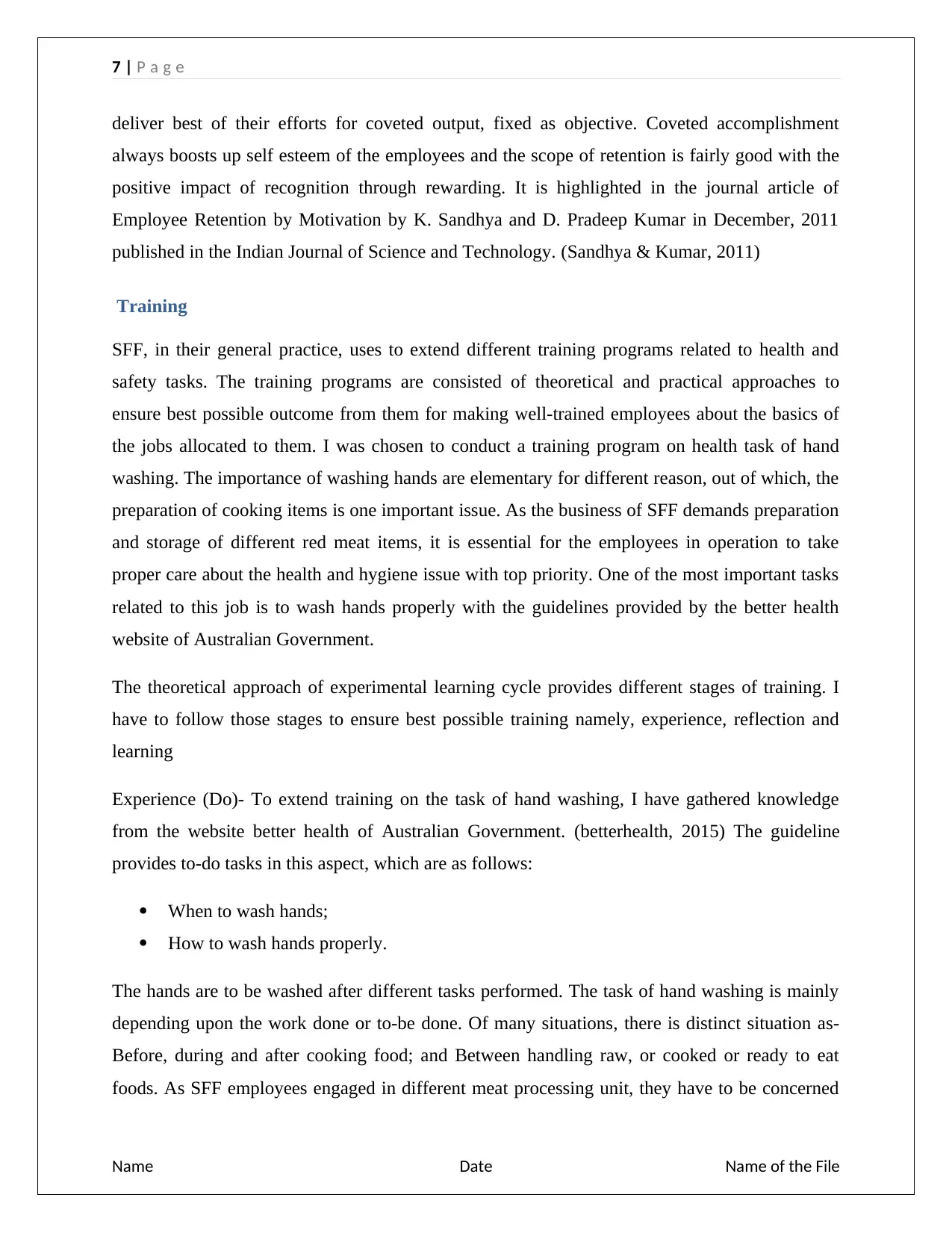
7 | P a g e
deliver best of their efforts for coveted output, fixed as objective. Coveted accomplishment
always boosts up self esteem of the employees and the scope of retention is fairly good with the
positive impact of recognition through rewarding. It is highlighted in the journal article of
Employee Retention by Motivation by K. Sandhya and D. Pradeep Kumar in December, 2011
published in the Indian Journal of Science and Technology. (Sandhya & Kumar, 2011)
Training
SFF, in their general practice, uses to extend different training programs related to health and
safety tasks. The training programs are consisted of theoretical and practical approaches to
ensure best possible outcome from them for making well-trained employees about the basics of
the jobs allocated to them. I was chosen to conduct a training program on health task of hand
washing. The importance of washing hands are elementary for different reason, out of which, the
preparation of cooking items is one important issue. As the business of SFF demands preparation
and storage of different red meat items, it is essential for the employees in operation to take
proper care about the health and hygiene issue with top priority. One of the most important tasks
related to this job is to wash hands properly with the guidelines provided by the better health
website of Australian Government.
The theoretical approach of experimental learning cycle provides different stages of training. I
have to follow those stages to ensure best possible training namely, experience, reflection and
learning
Experience (Do)- To extend training on the task of hand washing, I have gathered knowledge
from the website better health of Australian Government. (betterhealth, 2015) The guideline
provides to-do tasks in this aspect, which are as follows:
When to wash hands;
How to wash hands properly.
The hands are to be washed after different tasks performed. The task of hand washing is mainly
depending upon the work done or to-be done. Of many situations, there is distinct situation as-
Before, during and after cooking food; and Between handling raw, or cooked or ready to eat
foods. As SFF employees engaged in different meat processing unit, they have to be concerned
Name Date Name of the File
deliver best of their efforts for coveted output, fixed as objective. Coveted accomplishment
always boosts up self esteem of the employees and the scope of retention is fairly good with the
positive impact of recognition through rewarding. It is highlighted in the journal article of
Employee Retention by Motivation by K. Sandhya and D. Pradeep Kumar in December, 2011
published in the Indian Journal of Science and Technology. (Sandhya & Kumar, 2011)
Training
SFF, in their general practice, uses to extend different training programs related to health and
safety tasks. The training programs are consisted of theoretical and practical approaches to
ensure best possible outcome from them for making well-trained employees about the basics of
the jobs allocated to them. I was chosen to conduct a training program on health task of hand
washing. The importance of washing hands are elementary for different reason, out of which, the
preparation of cooking items is one important issue. As the business of SFF demands preparation
and storage of different red meat items, it is essential for the employees in operation to take
proper care about the health and hygiene issue with top priority. One of the most important tasks
related to this job is to wash hands properly with the guidelines provided by the better health
website of Australian Government.
The theoretical approach of experimental learning cycle provides different stages of training. I
have to follow those stages to ensure best possible training namely, experience, reflection and
learning
Experience (Do)- To extend training on the task of hand washing, I have gathered knowledge
from the website better health of Australian Government. (betterhealth, 2015) The guideline
provides to-do tasks in this aspect, which are as follows:
When to wash hands;
How to wash hands properly.
The hands are to be washed after different tasks performed. The task of hand washing is mainly
depending upon the work done or to-be done. Of many situations, there is distinct situation as-
Before, during and after cooking food; and Between handling raw, or cooked or ready to eat
foods. As SFF employees engaged in different meat processing unit, they have to be concerned
Name Date Name of the File
Paraphrase This Document
Need a fresh take? Get an instant paraphrase of this document with our AI Paraphraser
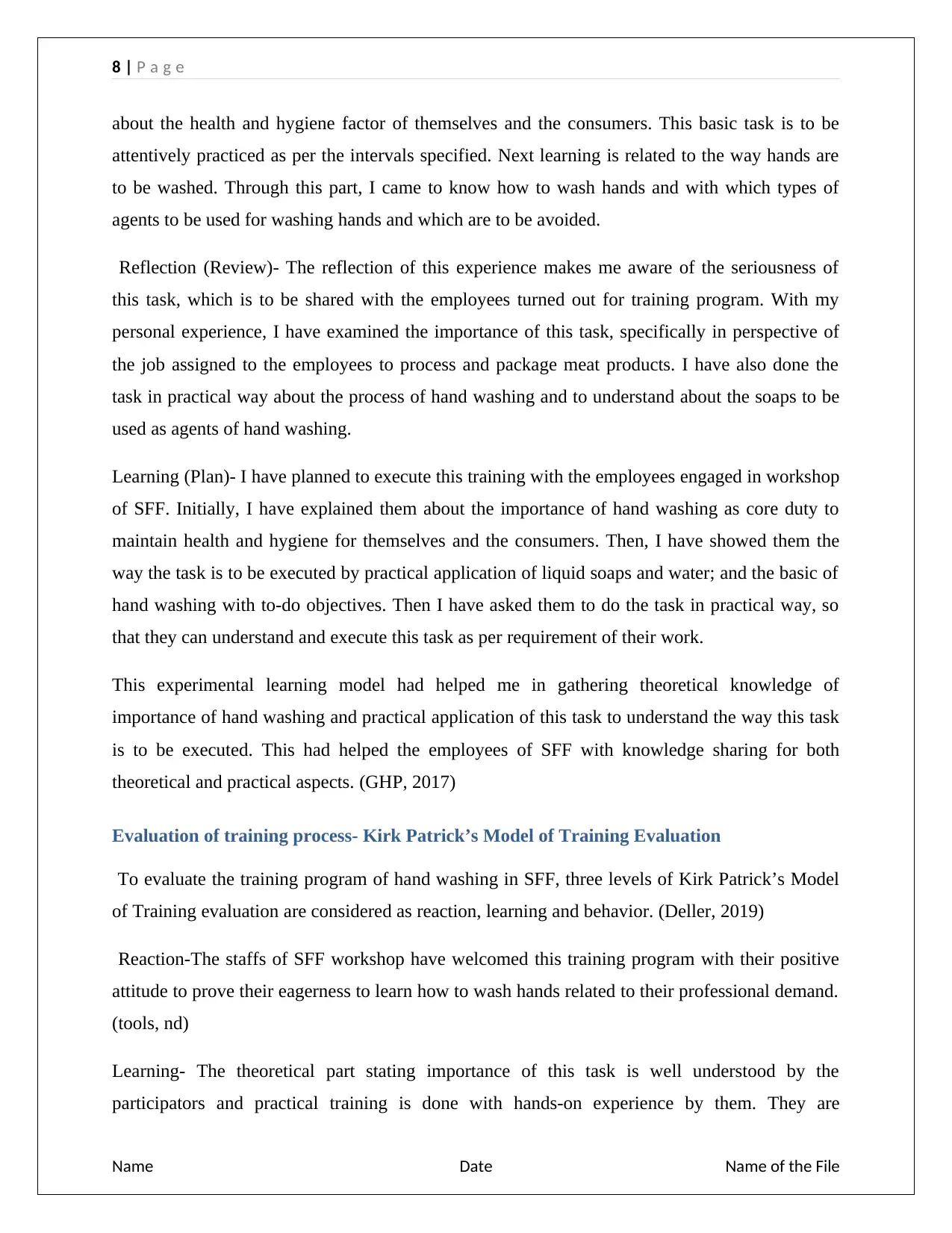
8 | P a g e
about the health and hygiene factor of themselves and the consumers. This basic task is to be
attentively practiced as per the intervals specified. Next learning is related to the way hands are
to be washed. Through this part, I came to know how to wash hands and with which types of
agents to be used for washing hands and which are to be avoided.
Reflection (Review)- The reflection of this experience makes me aware of the seriousness of
this task, which is to be shared with the employees turned out for training program. With my
personal experience, I have examined the importance of this task, specifically in perspective of
the job assigned to the employees to process and package meat products. I have also done the
task in practical way about the process of hand washing and to understand about the soaps to be
used as agents of hand washing.
Learning (Plan)- I have planned to execute this training with the employees engaged in workshop
of SFF. Initially, I have explained them about the importance of hand washing as core duty to
maintain health and hygiene for themselves and the consumers. Then, I have showed them the
way the task is to be executed by practical application of liquid soaps and water; and the basic of
hand washing with to-do objectives. Then I have asked them to do the task in practical way, so
that they can understand and execute this task as per requirement of their work.
This experimental learning model had helped me in gathering theoretical knowledge of
importance of hand washing and practical application of this task to understand the way this task
is to be executed. This had helped the employees of SFF with knowledge sharing for both
theoretical and practical aspects. (GHP, 2017)
Evaluation of training process- Kirk Patrick’s Model of Training Evaluation
To evaluate the training program of hand washing in SFF, three levels of Kirk Patrick’s Model
of Training evaluation are considered as reaction, learning and behavior. (Deller, 2019)
Reaction-The staffs of SFF workshop have welcomed this training program with their positive
attitude to prove their eagerness to learn how to wash hands related to their professional demand.
(tools, nd)
Learning- The theoretical part stating importance of this task is well understood by the
participators and practical training is done with hands-on experience by them. They are
Name Date Name of the File
about the health and hygiene factor of themselves and the consumers. This basic task is to be
attentively practiced as per the intervals specified. Next learning is related to the way hands are
to be washed. Through this part, I came to know how to wash hands and with which types of
agents to be used for washing hands and which are to be avoided.
Reflection (Review)- The reflection of this experience makes me aware of the seriousness of
this task, which is to be shared with the employees turned out for training program. With my
personal experience, I have examined the importance of this task, specifically in perspective of
the job assigned to the employees to process and package meat products. I have also done the
task in practical way about the process of hand washing and to understand about the soaps to be
used as agents of hand washing.
Learning (Plan)- I have planned to execute this training with the employees engaged in workshop
of SFF. Initially, I have explained them about the importance of hand washing as core duty to
maintain health and hygiene for themselves and the consumers. Then, I have showed them the
way the task is to be executed by practical application of liquid soaps and water; and the basic of
hand washing with to-do objectives. Then I have asked them to do the task in practical way, so
that they can understand and execute this task as per requirement of their work.
This experimental learning model had helped me in gathering theoretical knowledge of
importance of hand washing and practical application of this task to understand the way this task
is to be executed. This had helped the employees of SFF with knowledge sharing for both
theoretical and practical aspects. (GHP, 2017)
Evaluation of training process- Kirk Patrick’s Model of Training Evaluation
To evaluate the training program of hand washing in SFF, three levels of Kirk Patrick’s Model
of Training evaluation are considered as reaction, learning and behavior. (Deller, 2019)
Reaction-The staffs of SFF workshop have welcomed this training program with their positive
attitude to prove their eagerness to learn how to wash hands related to their professional demand.
(tools, nd)
Learning- The theoretical part stating importance of this task is well understood by the
participators and practical training is done with hands-on experience by them. They are
Name Date Name of the File
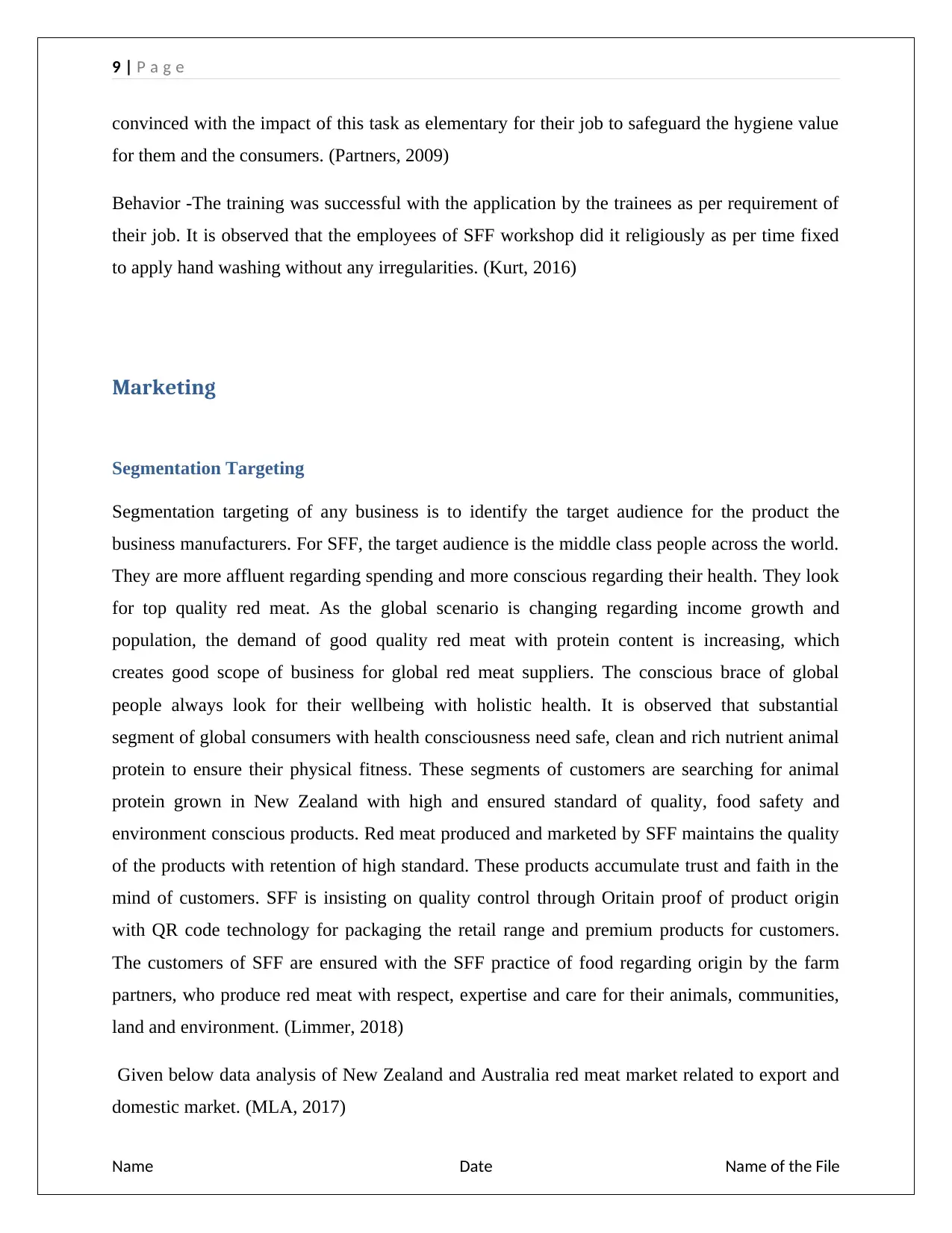
9 | P a g e
convinced with the impact of this task as elementary for their job to safeguard the hygiene value
for them and the consumers. (Partners, 2009)
Behavior -The training was successful with the application by the trainees as per requirement of
their job. It is observed that the employees of SFF workshop did it religiously as per time fixed
to apply hand washing without any irregularities. (Kurt, 2016)
Marketing
Segmentation Targeting
Segmentation targeting of any business is to identify the target audience for the product the
business manufacturers. For SFF, the target audience is the middle class people across the world.
They are more affluent regarding spending and more conscious regarding their health. They look
for top quality red meat. As the global scenario is changing regarding income growth and
population, the demand of good quality red meat with protein content is increasing, which
creates good scope of business for global red meat suppliers. The conscious brace of global
people always look for their wellbeing with holistic health. It is observed that substantial
segment of global consumers with health consciousness need safe, clean and rich nutrient animal
protein to ensure their physical fitness. These segments of customers are searching for animal
protein grown in New Zealand with high and ensured standard of quality, food safety and
environment conscious products. Red meat produced and marketed by SFF maintains the quality
of the products with retention of high standard. These products accumulate trust and faith in the
mind of customers. SFF is insisting on quality control through Oritain proof of product origin
with QR code technology for packaging the retail range and premium products for customers.
The customers of SFF are ensured with the SFF practice of food regarding origin by the farm
partners, who produce red meat with respect, expertise and care for their animals, communities,
land and environment. (Limmer, 2018)
Given below data analysis of New Zealand and Australia red meat market related to export and
domestic market. (MLA, 2017)
Name Date Name of the File
convinced with the impact of this task as elementary for their job to safeguard the hygiene value
for them and the consumers. (Partners, 2009)
Behavior -The training was successful with the application by the trainees as per requirement of
their job. It is observed that the employees of SFF workshop did it religiously as per time fixed
to apply hand washing without any irregularities. (Kurt, 2016)
Marketing
Segmentation Targeting
Segmentation targeting of any business is to identify the target audience for the product the
business manufacturers. For SFF, the target audience is the middle class people across the world.
They are more affluent regarding spending and more conscious regarding their health. They look
for top quality red meat. As the global scenario is changing regarding income growth and
population, the demand of good quality red meat with protein content is increasing, which
creates good scope of business for global red meat suppliers. The conscious brace of global
people always look for their wellbeing with holistic health. It is observed that substantial
segment of global consumers with health consciousness need safe, clean and rich nutrient animal
protein to ensure their physical fitness. These segments of customers are searching for animal
protein grown in New Zealand with high and ensured standard of quality, food safety and
environment conscious products. Red meat produced and marketed by SFF maintains the quality
of the products with retention of high standard. These products accumulate trust and faith in the
mind of customers. SFF is insisting on quality control through Oritain proof of product origin
with QR code technology for packaging the retail range and premium products for customers.
The customers of SFF are ensured with the SFF practice of food regarding origin by the farm
partners, who produce red meat with respect, expertise and care for their animals, communities,
land and environment. (Limmer, 2018)
Given below data analysis of New Zealand and Australia red meat market related to export and
domestic market. (MLA, 2017)
Name Date Name of the File
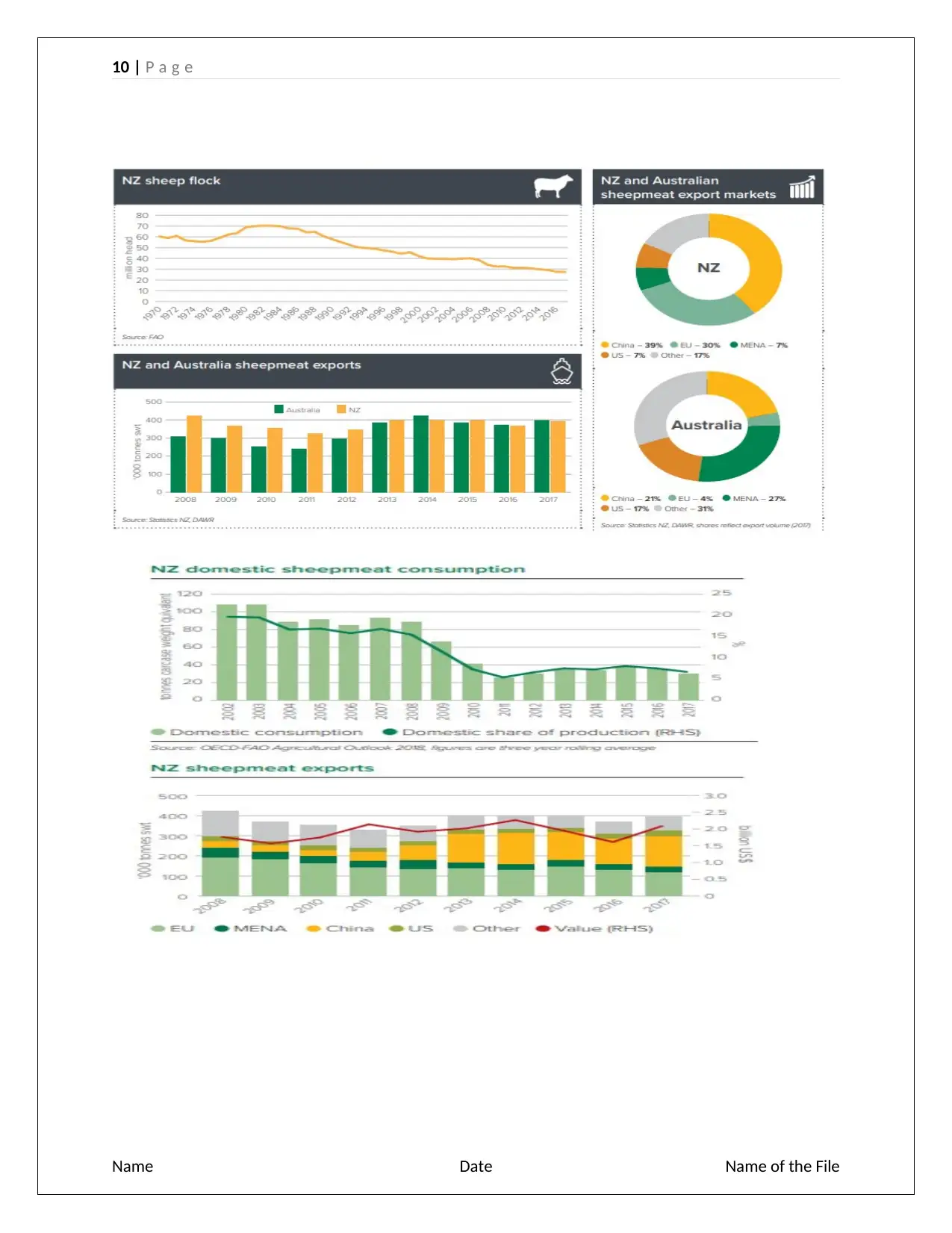
10 | P a g e
Name Date Name of the File
Name Date Name of the File
Secure Best Marks with AI Grader
Need help grading? Try our AI Grader for instant feedback on your assignments.
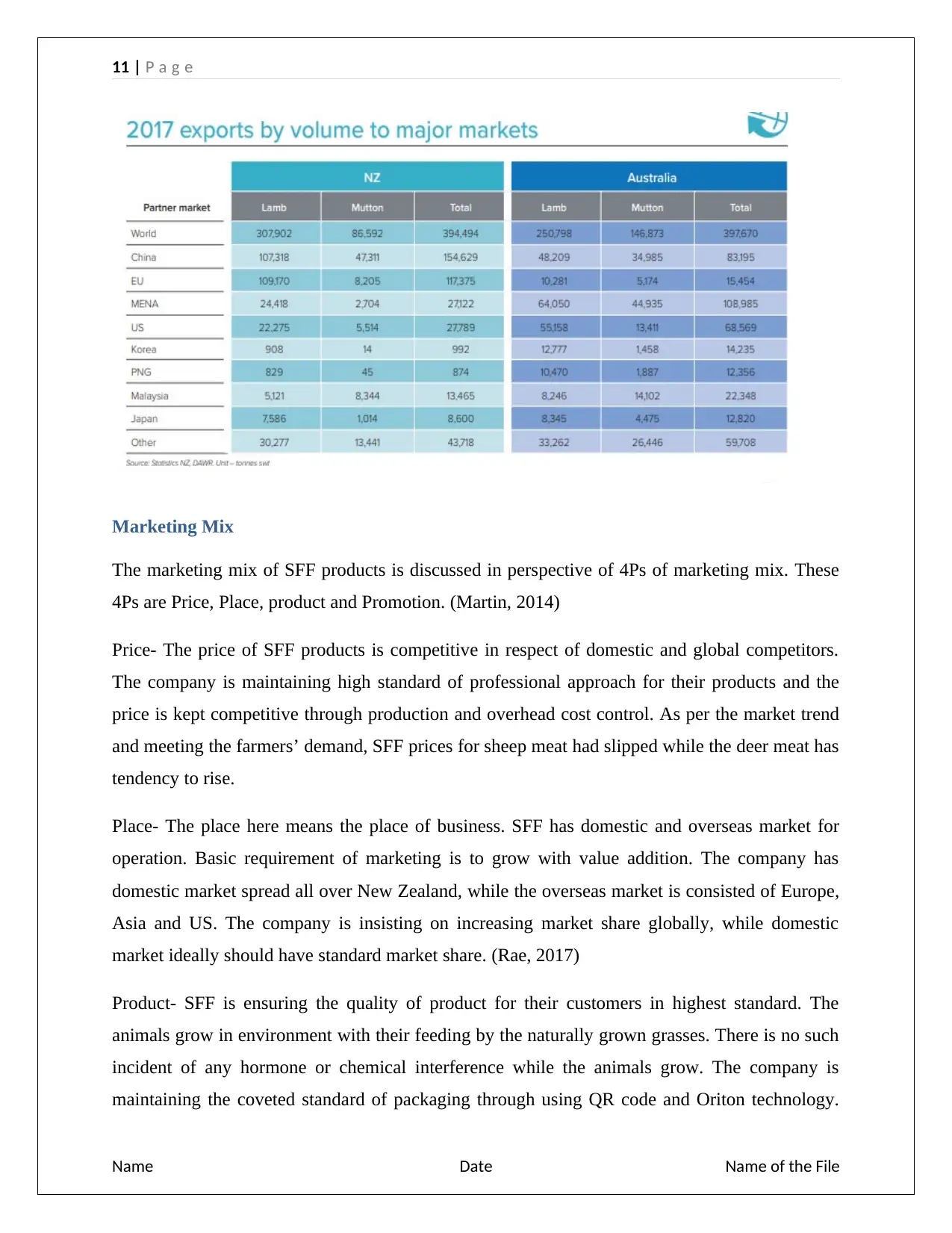
11 | P a g e
Marketing Mix
The marketing mix of SFF products is discussed in perspective of 4Ps of marketing mix. These
4Ps are Price, Place, product and Promotion. (Martin, 2014)
Price- The price of SFF products is competitive in respect of domestic and global competitors.
The company is maintaining high standard of professional approach for their products and the
price is kept competitive through production and overhead cost control. As per the market trend
and meeting the farmers’ demand, SFF prices for sheep meat had slipped while the deer meat has
tendency to rise.
Place- The place here means the place of business. SFF has domestic and overseas market for
operation. Basic requirement of marketing is to grow with value addition. The company has
domestic market spread all over New Zealand, while the overseas market is consisted of Europe,
Asia and US. The company is insisting on increasing market share globally, while domestic
market ideally should have standard market share. (Rae, 2017)
Product- SFF is ensuring the quality of product for their customers in highest standard. The
animals grow in environment with their feeding by the naturally grown grasses. There is no such
incident of any hormone or chemical interference while the animals grow. The company is
maintaining the coveted standard of packaging through using QR code and Oriton technology.
Name Date Name of the File
Marketing Mix
The marketing mix of SFF products is discussed in perspective of 4Ps of marketing mix. These
4Ps are Price, Place, product and Promotion. (Martin, 2014)
Price- The price of SFF products is competitive in respect of domestic and global competitors.
The company is maintaining high standard of professional approach for their products and the
price is kept competitive through production and overhead cost control. As per the market trend
and meeting the farmers’ demand, SFF prices for sheep meat had slipped while the deer meat has
tendency to rise.
Place- The place here means the place of business. SFF has domestic and overseas market for
operation. Basic requirement of marketing is to grow with value addition. The company has
domestic market spread all over New Zealand, while the overseas market is consisted of Europe,
Asia and US. The company is insisting on increasing market share globally, while domestic
market ideally should have standard market share. (Rae, 2017)
Product- SFF is ensuring the quality of product for their customers in highest standard. The
animals grow in environment with their feeding by the naturally grown grasses. There is no such
incident of any hormone or chemical interference while the animals grow. The company is
maintaining the coveted standard of packaging through using QR code and Oriton technology.
Name Date Name of the File
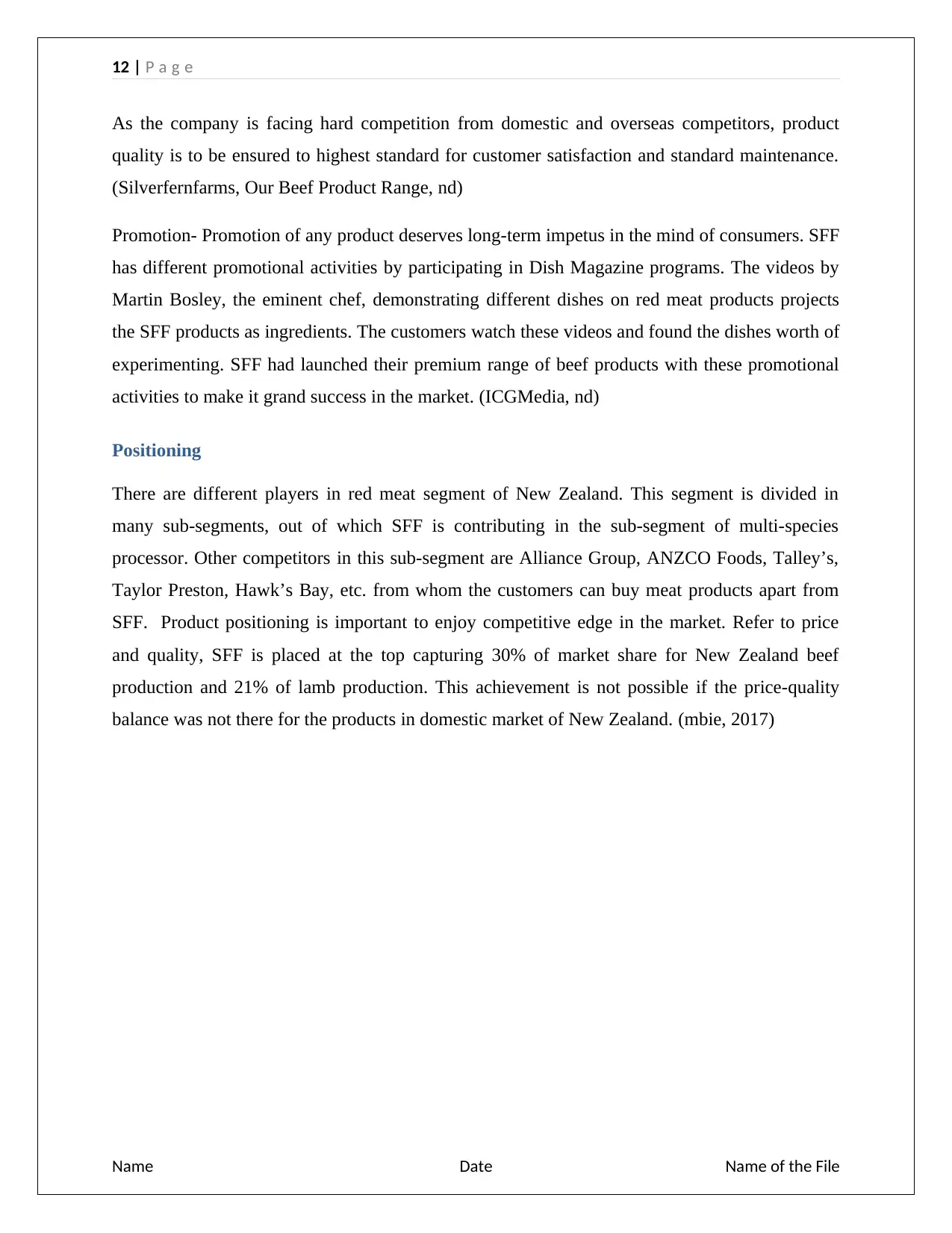
12 | P a g e
As the company is facing hard competition from domestic and overseas competitors, product
quality is to be ensured to highest standard for customer satisfaction and standard maintenance.
(Silverfernfarms, Our Beef Product Range, nd)
Promotion- Promotion of any product deserves long-term impetus in the mind of consumers. SFF
has different promotional activities by participating in Dish Magazine programs. The videos by
Martin Bosley, the eminent chef, demonstrating different dishes on red meat products projects
the SFF products as ingredients. The customers watch these videos and found the dishes worth of
experimenting. SFF had launched their premium range of beef products with these promotional
activities to make it grand success in the market. (ICGMedia, nd)
Positioning
There are different players in red meat segment of New Zealand. This segment is divided in
many sub-segments, out of which SFF is contributing in the sub-segment of multi-species
processor. Other competitors in this sub-segment are Alliance Group, ANZCO Foods, Talley’s,
Taylor Preston, Hawk’s Bay, etc. from whom the customers can buy meat products apart from
SFF. Product positioning is important to enjoy competitive edge in the market. Refer to price
and quality, SFF is placed at the top capturing 30% of market share for New Zealand beef
production and 21% of lamb production. This achievement is not possible if the price-quality
balance was not there for the products in domestic market of New Zealand. (mbie, 2017)
Name Date Name of the File
As the company is facing hard competition from domestic and overseas competitors, product
quality is to be ensured to highest standard for customer satisfaction and standard maintenance.
(Silverfernfarms, Our Beef Product Range, nd)
Promotion- Promotion of any product deserves long-term impetus in the mind of consumers. SFF
has different promotional activities by participating in Dish Magazine programs. The videos by
Martin Bosley, the eminent chef, demonstrating different dishes on red meat products projects
the SFF products as ingredients. The customers watch these videos and found the dishes worth of
experimenting. SFF had launched their premium range of beef products with these promotional
activities to make it grand success in the market. (ICGMedia, nd)
Positioning
There are different players in red meat segment of New Zealand. This segment is divided in
many sub-segments, out of which SFF is contributing in the sub-segment of multi-species
processor. Other competitors in this sub-segment are Alliance Group, ANZCO Foods, Talley’s,
Taylor Preston, Hawk’s Bay, etc. from whom the customers can buy meat products apart from
SFF. Product positioning is important to enjoy competitive edge in the market. Refer to price
and quality, SFF is placed at the top capturing 30% of market share for New Zealand beef
production and 21% of lamb production. This achievement is not possible if the price-quality
balance was not there for the products in domestic market of New Zealand. (mbie, 2017)
Name Date Name of the File
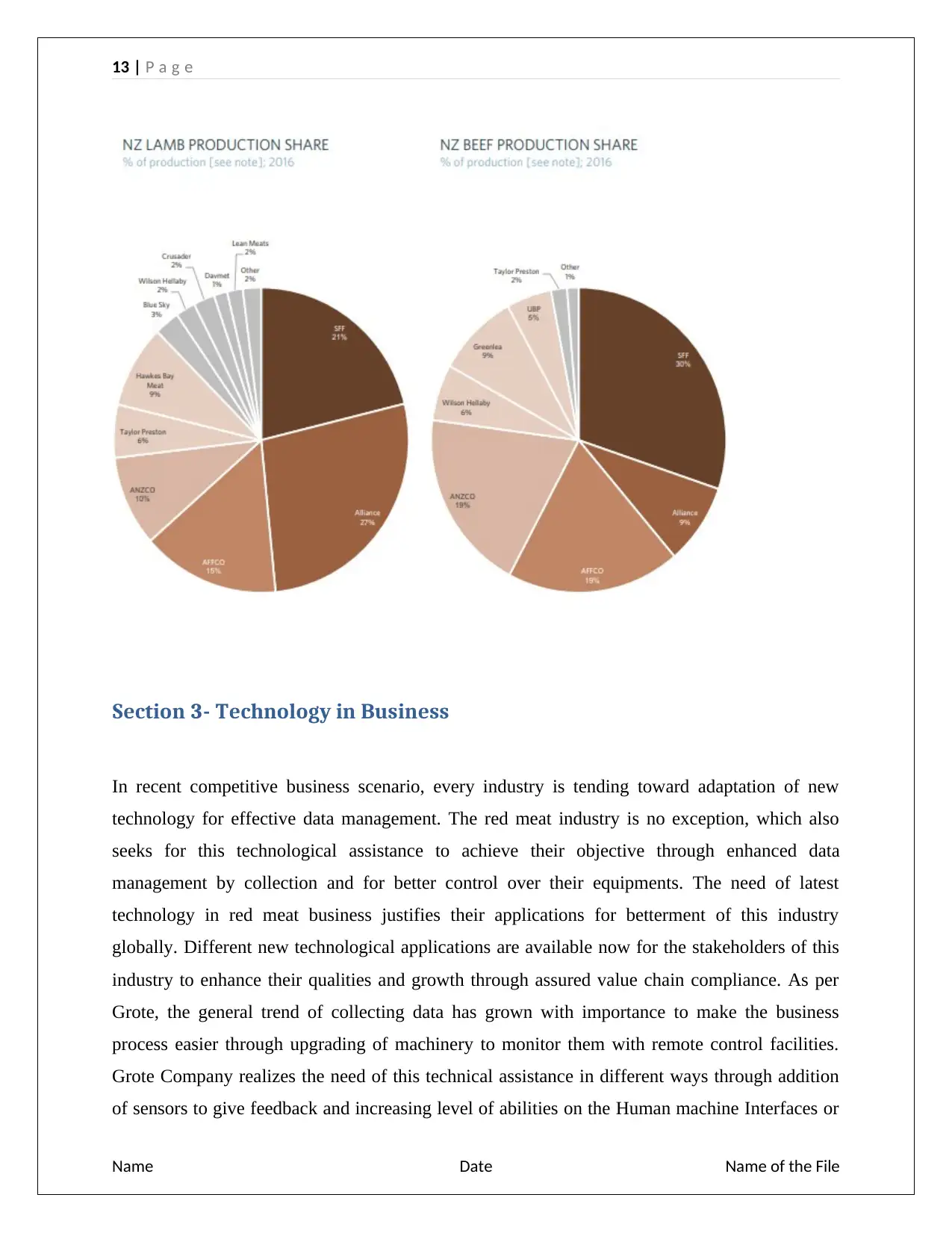
13 | P a g e
Section 3- Technology in Business
In recent competitive business scenario, every industry is tending toward adaptation of new
technology for effective data management. The red meat industry is no exception, which also
seeks for this technological assistance to achieve their objective through enhanced data
management by collection and for better control over their equipments. The need of latest
technology in red meat business justifies their applications for betterment of this industry
globally. Different new technological applications are available now for the stakeholders of this
industry to enhance their qualities and growth through assured value chain compliance. As per
Grote, the general trend of collecting data has grown with importance to make the business
process easier through upgrading of machinery to monitor them with remote control facilities.
Grote Company realizes the need of this technical assistance in different ways through addition
of sensors to give feedback and increasing level of abilities on the Human machine Interfaces or
Name Date Name of the File
Section 3- Technology in Business
In recent competitive business scenario, every industry is tending toward adaptation of new
technology for effective data management. The red meat industry is no exception, which also
seeks for this technological assistance to achieve their objective through enhanced data
management by collection and for better control over their equipments. The need of latest
technology in red meat business justifies their applications for betterment of this industry
globally. Different new technological applications are available now for the stakeholders of this
industry to enhance their qualities and growth through assured value chain compliance. As per
Grote, the general trend of collecting data has grown with importance to make the business
process easier through upgrading of machinery to monitor them with remote control facilities.
Grote Company realizes the need of this technical assistance in different ways through addition
of sensors to give feedback and increasing level of abilities on the Human machine Interfaces or
Name Date Name of the File
Paraphrase This Document
Need a fresh take? Get an instant paraphrase of this document with our AI Paraphraser
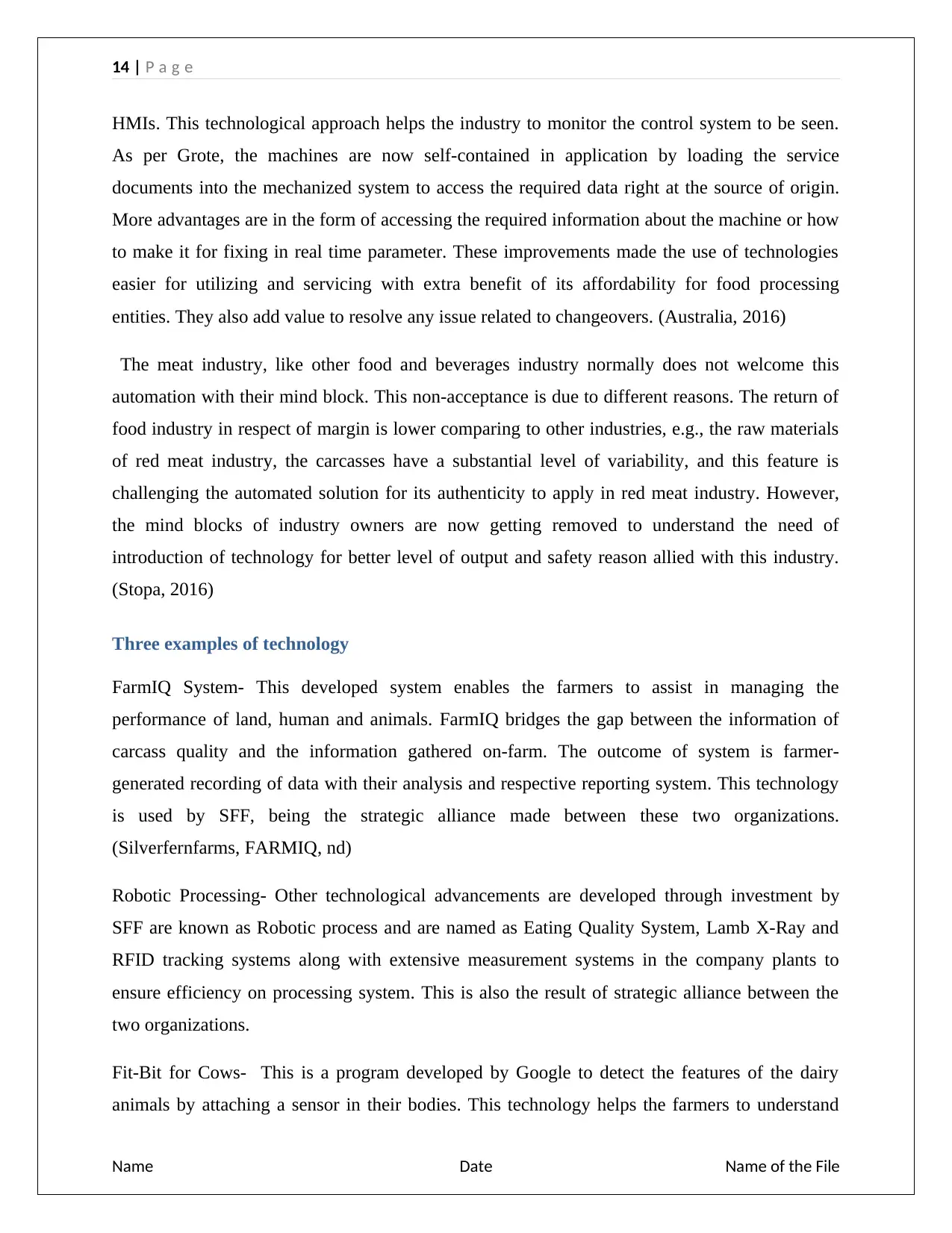
14 | P a g e
HMIs. This technological approach helps the industry to monitor the control system to be seen.
As per Grote, the machines are now self-contained in application by loading the service
documents into the mechanized system to access the required data right at the source of origin.
More advantages are in the form of accessing the required information about the machine or how
to make it for fixing in real time parameter. These improvements made the use of technologies
easier for utilizing and servicing with extra benefit of its affordability for food processing
entities. They also add value to resolve any issue related to changeovers. (Australia, 2016)
The meat industry, like other food and beverages industry normally does not welcome this
automation with their mind block. This non-acceptance is due to different reasons. The return of
food industry in respect of margin is lower comparing to other industries, e.g., the raw materials
of red meat industry, the carcasses have a substantial level of variability, and this feature is
challenging the automated solution for its authenticity to apply in red meat industry. However,
the mind blocks of industry owners are now getting removed to understand the need of
introduction of technology for better level of output and safety reason allied with this industry.
(Stopa, 2016)
Three examples of technology
FarmIQ System- This developed system enables the farmers to assist in managing the
performance of land, human and animals. FarmIQ bridges the gap between the information of
carcass quality and the information gathered on-farm. The outcome of system is farmer-
generated recording of data with their analysis and respective reporting system. This technology
is used by SFF, being the strategic alliance made between these two organizations.
(Silverfernfarms, FARMIQ, nd)
Robotic Processing- Other technological advancements are developed through investment by
SFF are known as Robotic process and are named as Eating Quality System, Lamb X-Ray and
RFID tracking systems along with extensive measurement systems in the company plants to
ensure efficiency on processing system. This is also the result of strategic alliance between the
two organizations.
Fit-Bit for Cows- This is a program developed by Google to detect the features of the dairy
animals by attaching a sensor in their bodies. This technology helps the farmers to understand
Name Date Name of the File
HMIs. This technological approach helps the industry to monitor the control system to be seen.
As per Grote, the machines are now self-contained in application by loading the service
documents into the mechanized system to access the required data right at the source of origin.
More advantages are in the form of accessing the required information about the machine or how
to make it for fixing in real time parameter. These improvements made the use of technologies
easier for utilizing and servicing with extra benefit of its affordability for food processing
entities. They also add value to resolve any issue related to changeovers. (Australia, 2016)
The meat industry, like other food and beverages industry normally does not welcome this
automation with their mind block. This non-acceptance is due to different reasons. The return of
food industry in respect of margin is lower comparing to other industries, e.g., the raw materials
of red meat industry, the carcasses have a substantial level of variability, and this feature is
challenging the automated solution for its authenticity to apply in red meat industry. However,
the mind blocks of industry owners are now getting removed to understand the need of
introduction of technology for better level of output and safety reason allied with this industry.
(Stopa, 2016)
Three examples of technology
FarmIQ System- This developed system enables the farmers to assist in managing the
performance of land, human and animals. FarmIQ bridges the gap between the information of
carcass quality and the information gathered on-farm. The outcome of system is farmer-
generated recording of data with their analysis and respective reporting system. This technology
is used by SFF, being the strategic alliance made between these two organizations.
(Silverfernfarms, FARMIQ, nd)
Robotic Processing- Other technological advancements are developed through investment by
SFF are known as Robotic process and are named as Eating Quality System, Lamb X-Ray and
RFID tracking systems along with extensive measurement systems in the company plants to
ensure efficiency on processing system. This is also the result of strategic alliance between the
two organizations.
Fit-Bit for Cows- This is a program developed by Google to detect the features of the dairy
animals by attaching a sensor in their bodies. This technology helps the farmers to understand
Name Date Name of the File
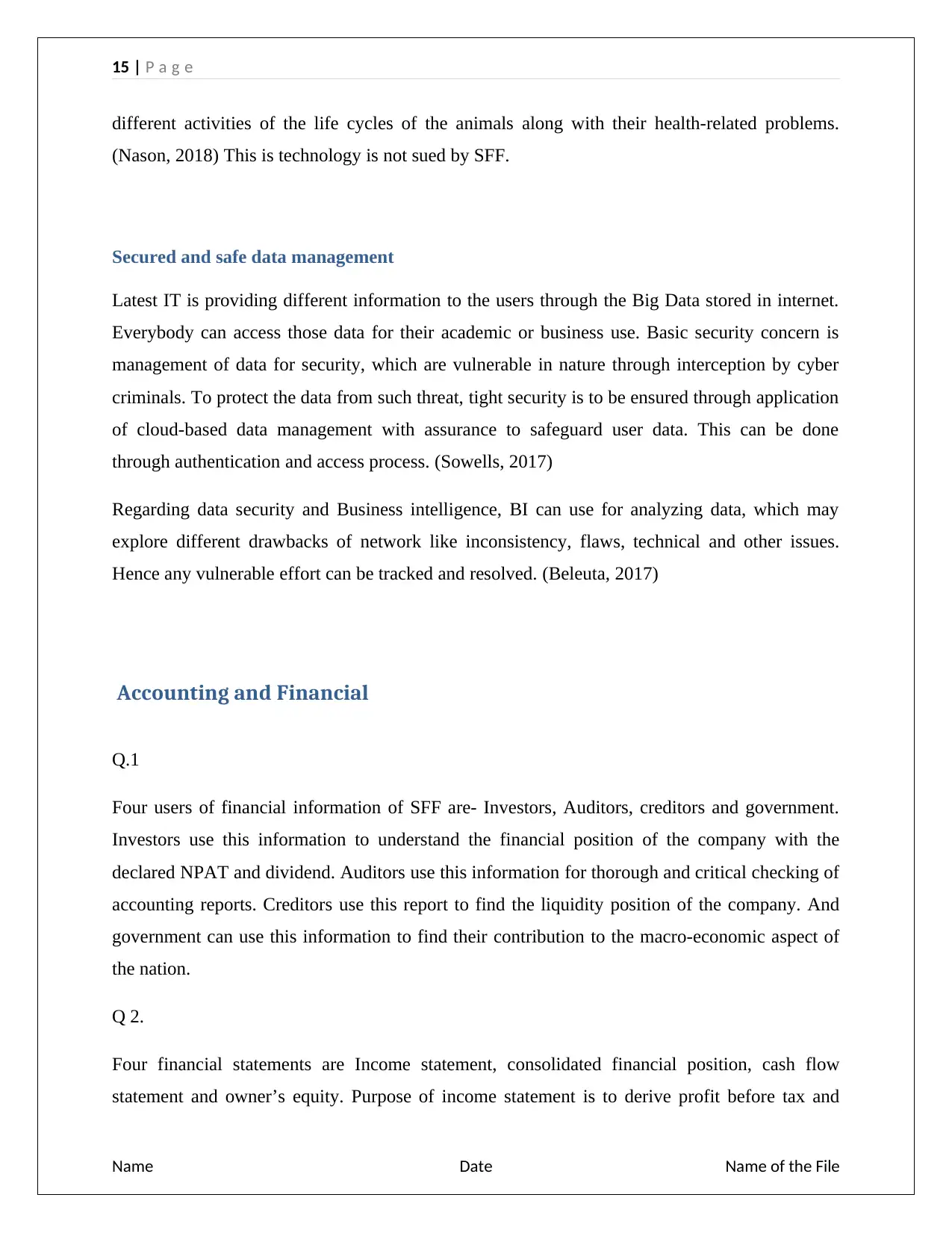
15 | P a g e
different activities of the life cycles of the animals along with their health-related problems.
(Nason, 2018) This is technology is not sued by SFF.
Secured and safe data management
Latest IT is providing different information to the users through the Big Data stored in internet.
Everybody can access those data for their academic or business use. Basic security concern is
management of data for security, which are vulnerable in nature through interception by cyber
criminals. To protect the data from such threat, tight security is to be ensured through application
of cloud-based data management with assurance to safeguard user data. This can be done
through authentication and access process. (Sowells, 2017)
Regarding data security and Business intelligence, BI can use for analyzing data, which may
explore different drawbacks of network like inconsistency, flaws, technical and other issues.
Hence any vulnerable effort can be tracked and resolved. (Beleuta, 2017)
Accounting and Financial
Q.1
Four users of financial information of SFF are- Investors, Auditors, creditors and government.
Investors use this information to understand the financial position of the company with the
declared NPAT and dividend. Auditors use this information for thorough and critical checking of
accounting reports. Creditors use this report to find the liquidity position of the company. And
government can use this information to find their contribution to the macro-economic aspect of
the nation.
Q 2.
Four financial statements are Income statement, consolidated financial position, cash flow
statement and owner’s equity. Purpose of income statement is to derive profit before tax and
Name Date Name of the File
different activities of the life cycles of the animals along with their health-related problems.
(Nason, 2018) This is technology is not sued by SFF.
Secured and safe data management
Latest IT is providing different information to the users through the Big Data stored in internet.
Everybody can access those data for their academic or business use. Basic security concern is
management of data for security, which are vulnerable in nature through interception by cyber
criminals. To protect the data from such threat, tight security is to be ensured through application
of cloud-based data management with assurance to safeguard user data. This can be done
through authentication and access process. (Sowells, 2017)
Regarding data security and Business intelligence, BI can use for analyzing data, which may
explore different drawbacks of network like inconsistency, flaws, technical and other issues.
Hence any vulnerable effort can be tracked and resolved. (Beleuta, 2017)
Accounting and Financial
Q.1
Four users of financial information of SFF are- Investors, Auditors, creditors and government.
Investors use this information to understand the financial position of the company with the
declared NPAT and dividend. Auditors use this information for thorough and critical checking of
accounting reports. Creditors use this report to find the liquidity position of the company. And
government can use this information to find their contribution to the macro-economic aspect of
the nation.
Q 2.
Four financial statements are Income statement, consolidated financial position, cash flow
statement and owner’s equity. Purpose of income statement is to derive profit before tax and
Name Date Name of the File
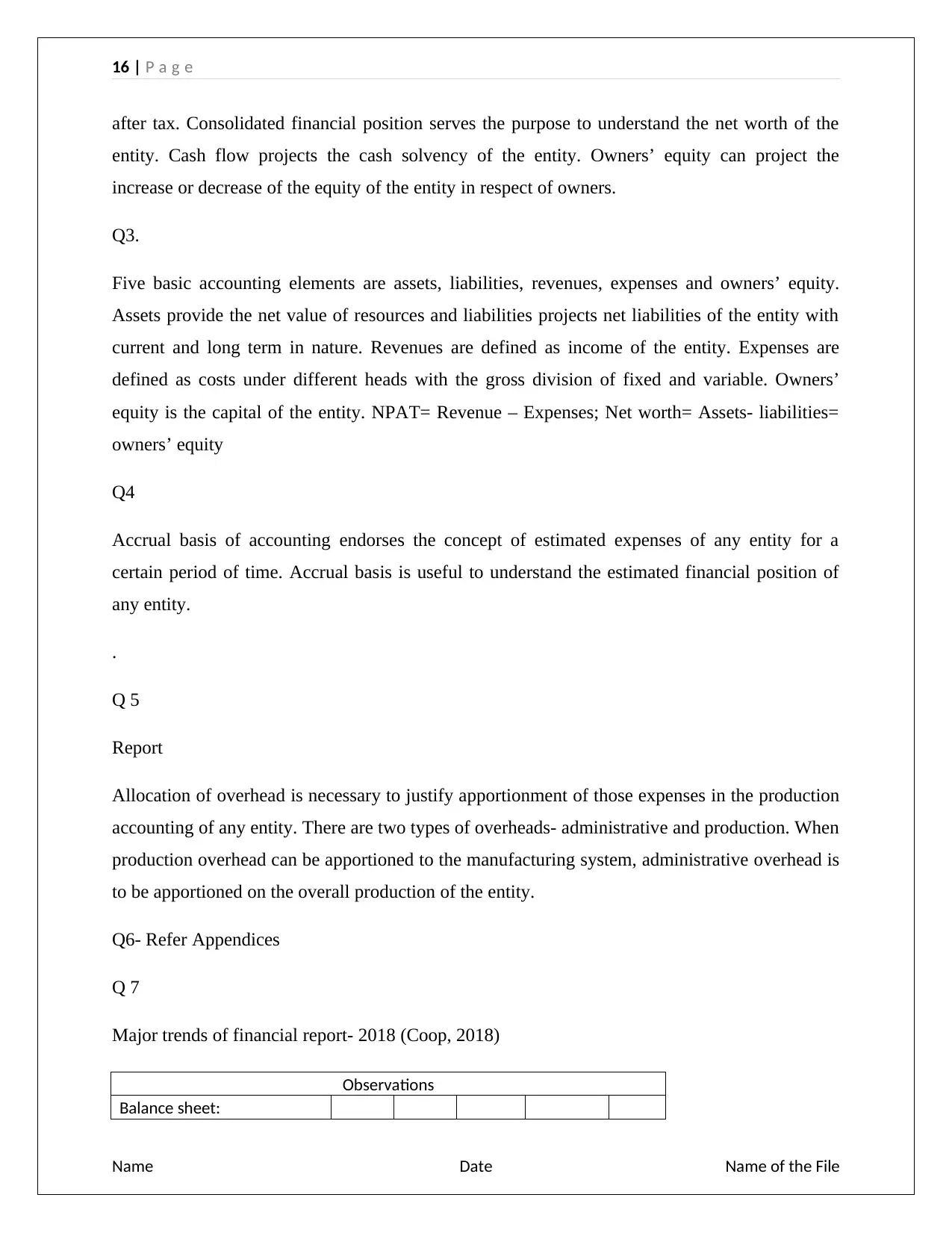
16 | P a g e
after tax. Consolidated financial position serves the purpose to understand the net worth of the
entity. Cash flow projects the cash solvency of the entity. Owners’ equity can project the
increase or decrease of the equity of the entity in respect of owners.
Q3.
Five basic accounting elements are assets, liabilities, revenues, expenses and owners’ equity.
Assets provide the net value of resources and liabilities projects net liabilities of the entity with
current and long term in nature. Revenues are defined as income of the entity. Expenses are
defined as costs under different heads with the gross division of fixed and variable. Owners’
equity is the capital of the entity. NPAT= Revenue – Expenses; Net worth= Assets- liabilities=
owners’ equity
Q4
Accrual basis of accounting endorses the concept of estimated expenses of any entity for a
certain period of time. Accrual basis is useful to understand the estimated financial position of
any entity.
.
Q 5
Report
Allocation of overhead is necessary to justify apportionment of those expenses in the production
accounting of any entity. There are two types of overheads- administrative and production. When
production overhead can be apportioned to the manufacturing system, administrative overhead is
to be apportioned on the overall production of the entity.
Q6- Refer Appendices
Q 7
Major trends of financial report- 2018 (Coop, 2018)
Observations
Balance sheet:
Name Date Name of the File
after tax. Consolidated financial position serves the purpose to understand the net worth of the
entity. Cash flow projects the cash solvency of the entity. Owners’ equity can project the
increase or decrease of the equity of the entity in respect of owners.
Q3.
Five basic accounting elements are assets, liabilities, revenues, expenses and owners’ equity.
Assets provide the net value of resources and liabilities projects net liabilities of the entity with
current and long term in nature. Revenues are defined as income of the entity. Expenses are
defined as costs under different heads with the gross division of fixed and variable. Owners’
equity is the capital of the entity. NPAT= Revenue – Expenses; Net worth= Assets- liabilities=
owners’ equity
Q4
Accrual basis of accounting endorses the concept of estimated expenses of any entity for a
certain period of time. Accrual basis is useful to understand the estimated financial position of
any entity.
.
Q 5
Report
Allocation of overhead is necessary to justify apportionment of those expenses in the production
accounting of any entity. There are two types of overheads- administrative and production. When
production overhead can be apportioned to the manufacturing system, administrative overhead is
to be apportioned on the overall production of the entity.
Q6- Refer Appendices
Q 7
Major trends of financial report- 2018 (Coop, 2018)
Observations
Balance sheet:
Name Date Name of the File
Secure Best Marks with AI Grader
Need help grading? Try our AI Grader for instant feedback on your assignments.
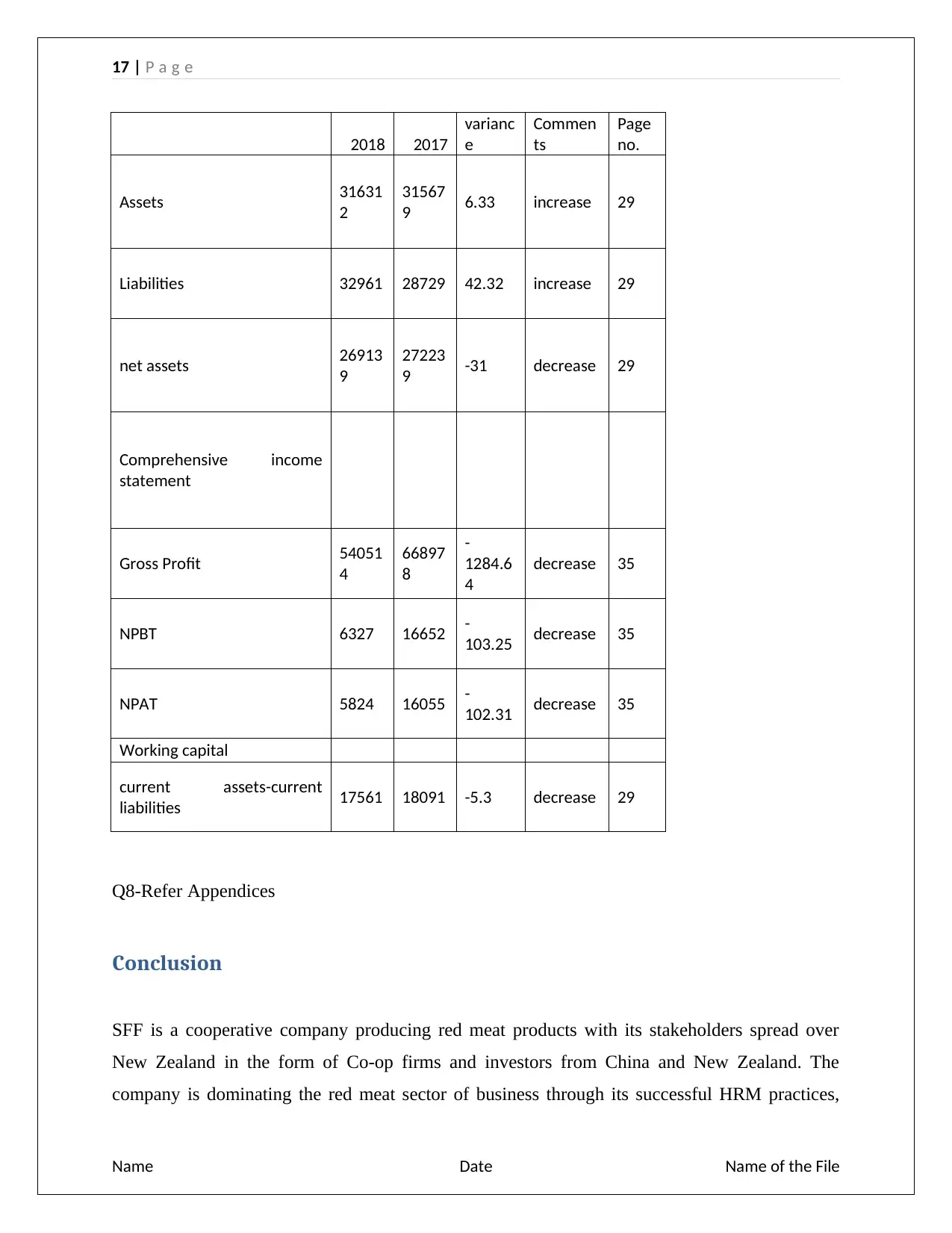
17 | P a g e
2018 2017
varianc
e
Commen
ts
Page
no.
Assets 31631
2
31567
9 6.33 increase 29
Liabilities 32961 28729 42.32 increase 29
net assets 26913
9
27223
9 -31 decrease 29
Comprehensive income
statement
Gross Profit 54051
4
66897
8
-
1284.6
4
decrease 35
NPBT 6327 16652 -
103.25 decrease 35
NPAT 5824 16055 -
102.31 decrease 35
Working capital
current assets-current
liabilities 17561 18091 -5.3 decrease 29
Q8-Refer Appendices
Conclusion
SFF is a cooperative company producing red meat products with its stakeholders spread over
New Zealand in the form of Co-op firms and investors from China and New Zealand. The
company is dominating the red meat sector of business through its successful HRM practices,
Name Date Name of the File
2018 2017
varianc
e
Commen
ts
Page
no.
Assets 31631
2
31567
9 6.33 increase 29
Liabilities 32961 28729 42.32 increase 29
net assets 26913
9
27223
9 -31 decrease 29
Comprehensive income
statement
Gross Profit 54051
4
66897
8
-
1284.6
4
decrease 35
NPBT 6327 16652 -
103.25 decrease 35
NPAT 5824 16055 -
102.31 decrease 35
Working capital
current assets-current
liabilities 17561 18091 -5.3 decrease 29
Q8-Refer Appendices
Conclusion
SFF is a cooperative company producing red meat products with its stakeholders spread over
New Zealand in the form of Co-op firms and investors from China and New Zealand. The
company is dominating the red meat sector of business through its successful HRM practices,
Name Date Name of the File
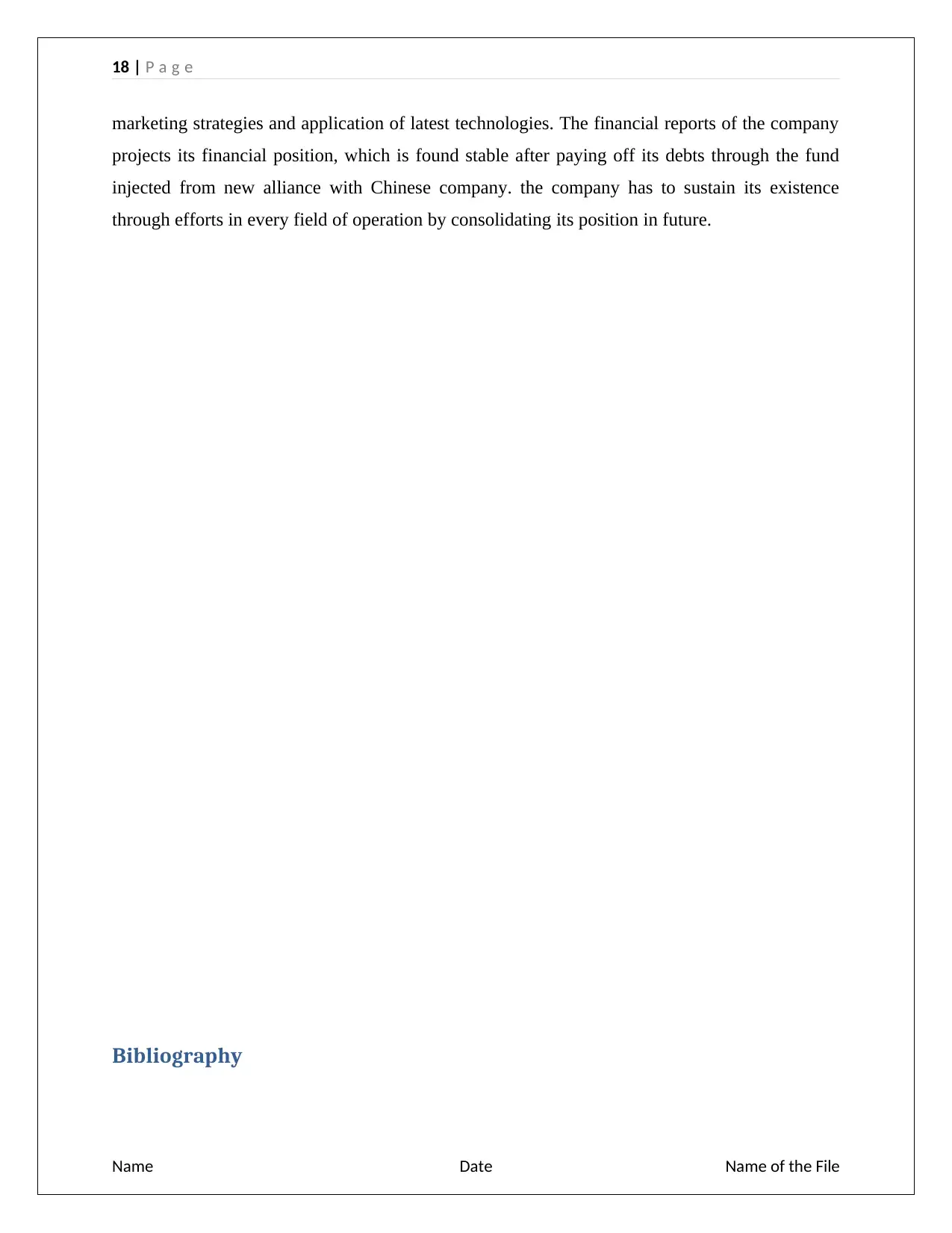
18 | P a g e
marketing strategies and application of latest technologies. The financial reports of the company
projects its financial position, which is found stable after paying off its debts through the fund
injected from new alliance with Chinese company. the company has to sustain its existence
through efforts in every field of operation by consolidating its position in future.
Bibliography
Name Date Name of the File
marketing strategies and application of latest technologies. The financial reports of the company
projects its financial position, which is found stable after paying off its debts through the fund
injected from new alliance with Chinese company. the company has to sustain its existence
through efforts in every field of operation by consolidating its position in future.
Bibliography
Name Date Name of the File

19 | P a g e
Australia, M. a. (2016). New technology investment to "transform" meat industry. MLA.
Beleuta, V. (2017, June 20). Data privacy and security in Business Intelligence and Analytics. Retrieved May 9,
2019, from semanticsholar website:
https://pdfs.semanticscholar.org/93ad/c50037259b66127d5bf1ea6d15ee7dc1b893.pdf
betterhealth. (2015, November 4). Handwashing - why it's important. Retrieved May 8, 2019, from betterhealth
webiste, Govt of Australia: https://www.betterhealth.vic.gov.au/health/conditionsandtreatments/
handwashing-why-its-important
Coop, S. (2018). Annual Financial Reprot 2018. Dunedin: Sliver Fern Farms.
Deller, J. (2019, February 18). How to Master the Kirkpatrick Model of Training Evaluation in 6 Simple Steps.
Retrieved May 8, 2019, from kodosurvey website: https://kodosurvey.com/blog/how-master-
kirkpatrick-model-training-evaluation-6-simple-steps
Farms, S. F. (nd). About Us. Retrieved May 7, 2019, from Silver Fern Farms website:
http://www.silverfernfarms.coop/about-us/our-news/
GHP. (2017). Why Handwashing. Retrieved May 8, 2019, from Global Hndwashing website:
https://globalhandwashing.org/about-handwashing/why-handwashing/health/
ICGMedia. (nd). Silver Fern Farms - Best of Beef. Retrieved May 9, 2019, from tangiblemedia website:
https://www.tangiblemedia.co.nz/content-marketing/silver-fern-farms-best-beef
Jahan, S. (nd). Maslow’s Need Hierarchy. Retrieved May 8, 2019, from HRMP website:
https://hrmpractice.com/maslows-need-hierarchy/
Kurt, S. (2016, October 24). Kirkpatrick Model: Four Levels of Learning Evaluation. Retrieved May 8, 2019, from
Educational Technology website: https://educationaltechnology.net/kirkpatrick-model-four-levels-
learning-evaluation/
Limmer, S. (2018). Sustainability Reprot-2018. Retrieved May 9, 2019, from Silver Fern farms website:
https://www.silverfernfarms.de/assets/Sustainability-Report-2018.pdf
Martin. (2014, August 5). Understanding the Marketing Mix Concept – 4Ps. Retrieved May 9, 2019, from
cleverism website: https://www.cleverism.com/understanding-marketing-mix-concept-4ps/
Name Date Name of the File
Australia, M. a. (2016). New technology investment to "transform" meat industry. MLA.
Beleuta, V. (2017, June 20). Data privacy and security in Business Intelligence and Analytics. Retrieved May 9,
2019, from semanticsholar website:
https://pdfs.semanticscholar.org/93ad/c50037259b66127d5bf1ea6d15ee7dc1b893.pdf
betterhealth. (2015, November 4). Handwashing - why it's important. Retrieved May 8, 2019, from betterhealth
webiste, Govt of Australia: https://www.betterhealth.vic.gov.au/health/conditionsandtreatments/
handwashing-why-its-important
Coop, S. (2018). Annual Financial Reprot 2018. Dunedin: Sliver Fern Farms.
Deller, J. (2019, February 18). How to Master the Kirkpatrick Model of Training Evaluation in 6 Simple Steps.
Retrieved May 8, 2019, from kodosurvey website: https://kodosurvey.com/blog/how-master-
kirkpatrick-model-training-evaluation-6-simple-steps
Farms, S. F. (nd). About Us. Retrieved May 7, 2019, from Silver Fern Farms website:
http://www.silverfernfarms.coop/about-us/our-news/
GHP. (2017). Why Handwashing. Retrieved May 8, 2019, from Global Hndwashing website:
https://globalhandwashing.org/about-handwashing/why-handwashing/health/
ICGMedia. (nd). Silver Fern Farms - Best of Beef. Retrieved May 9, 2019, from tangiblemedia website:
https://www.tangiblemedia.co.nz/content-marketing/silver-fern-farms-best-beef
Jahan, S. (nd). Maslow’s Need Hierarchy. Retrieved May 8, 2019, from HRMP website:
https://hrmpractice.com/maslows-need-hierarchy/
Kurt, S. (2016, October 24). Kirkpatrick Model: Four Levels of Learning Evaluation. Retrieved May 8, 2019, from
Educational Technology website: https://educationaltechnology.net/kirkpatrick-model-four-levels-
learning-evaluation/
Limmer, S. (2018). Sustainability Reprot-2018. Retrieved May 9, 2019, from Silver Fern farms website:
https://www.silverfernfarms.de/assets/Sustainability-Report-2018.pdf
Martin. (2014, August 5). Understanding the Marketing Mix Concept – 4Ps. Retrieved May 9, 2019, from
cleverism website: https://www.cleverism.com/understanding-marketing-mix-concept-4ps/
Name Date Name of the File
Paraphrase This Document
Need a fresh take? Get an instant paraphrase of this document with our AI Paraphraser
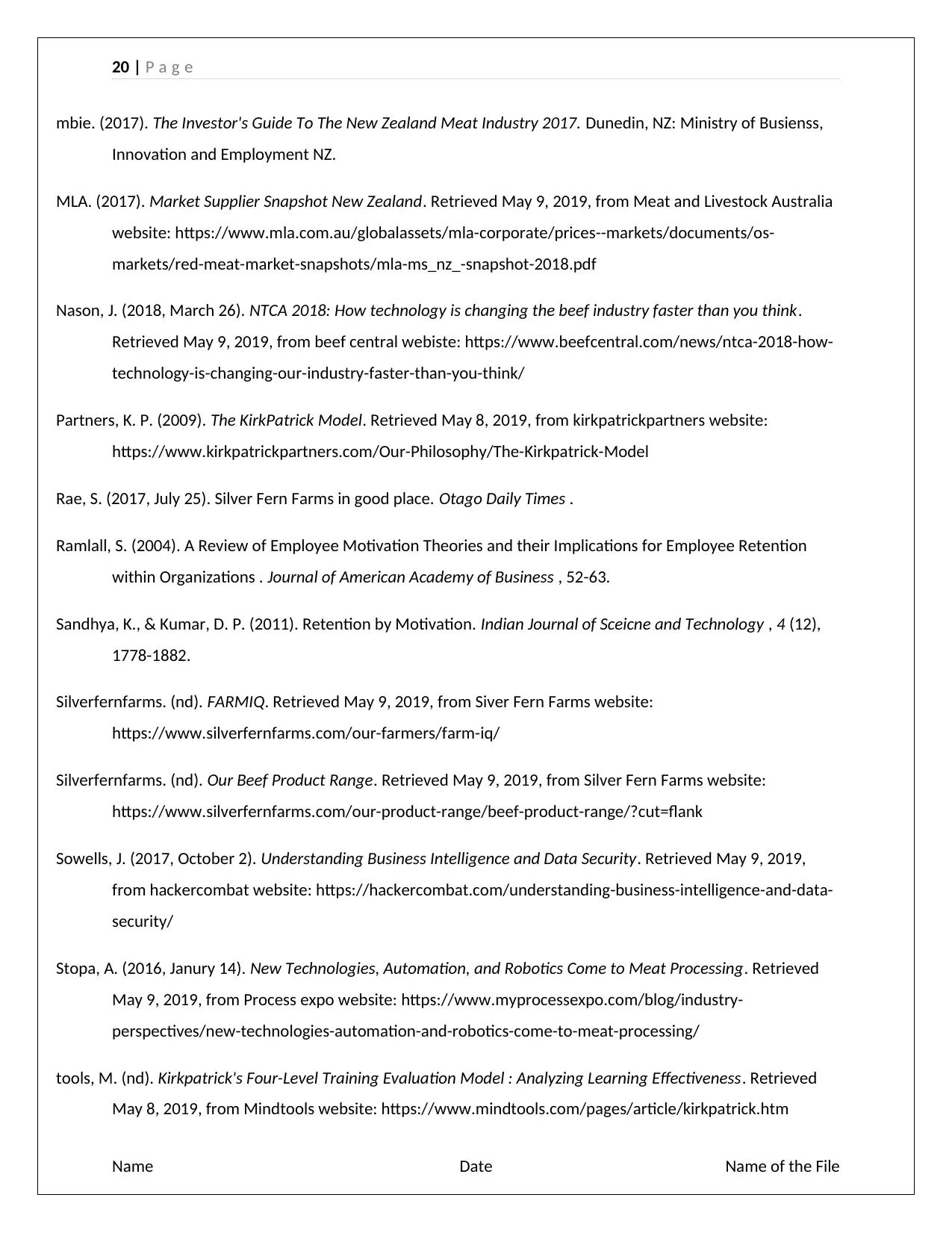
20 | P a g e
mbie. (2017). The Investor's Guide To The New Zealand Meat Industry 2017. Dunedin, NZ: Ministry of Busienss,
Innovation and Employment NZ.
MLA. (2017). Market Supplier Snapshot New Zealand. Retrieved May 9, 2019, from Meat and Livestock Australia
website: https://www.mla.com.au/globalassets/mla-corporate/prices--markets/documents/os-
markets/red-meat-market-snapshots/mla-ms_nz_-snapshot-2018.pdf
Nason, J. (2018, March 26). NTCA 2018: How technology is changing the beef industry faster than you think.
Retrieved May 9, 2019, from beef central webiste: https://www.beefcentral.com/news/ntca-2018-how-
technology-is-changing-our-industry-faster-than-you-think/
Partners, K. P. (2009). The KirkPatrick Model. Retrieved May 8, 2019, from kirkpatrickpartners website:
https://www.kirkpatrickpartners.com/Our-Philosophy/The-Kirkpatrick-Model
Rae, S. (2017, July 25). Silver Fern Farms in good place. Otago Daily Times .
Ramlall, S. (2004). A Review of Employee Motivation Theories and their Implications for Employee Retention
within Organizations . Journal of American Academy of Business , 52-63.
Sandhya, K., & Kumar, D. P. (2011). Retention by Motivation. Indian Journal of Sceicne and Technology , 4 (12),
1778-1882.
Silverfernfarms. (nd). FARMIQ. Retrieved May 9, 2019, from Siver Fern Farms website:
https://www.silverfernfarms.com/our-farmers/farm-iq/
Silverfernfarms. (nd). Our Beef Product Range. Retrieved May 9, 2019, from Silver Fern Farms website:
https://www.silverfernfarms.com/our-product-range/beef-product-range/?cut=flank
Sowells, J. (2017, October 2). Understanding Business Intelligence and Data Security. Retrieved May 9, 2019,
from hackercombat website: https://hackercombat.com/understanding-business-intelligence-and-data-
security/
Stopa, A. (2016, Janury 14). New Technologies, Automation, and Robotics Come to Meat Processing. Retrieved
May 9, 2019, from Process expo website: https://www.myprocessexpo.com/blog/industry-
perspectives/new-technologies-automation-and-robotics-come-to-meat-processing/
tools, M. (nd). Kirkpatrick's Four-Level Training Evaluation Model : Analyzing Learning Effectiveness. Retrieved
May 8, 2019, from Mindtools website: https://www.mindtools.com/pages/article/kirkpatrick.htm
Name Date Name of the File
mbie. (2017). The Investor's Guide To The New Zealand Meat Industry 2017. Dunedin, NZ: Ministry of Busienss,
Innovation and Employment NZ.
MLA. (2017). Market Supplier Snapshot New Zealand. Retrieved May 9, 2019, from Meat and Livestock Australia
website: https://www.mla.com.au/globalassets/mla-corporate/prices--markets/documents/os-
markets/red-meat-market-snapshots/mla-ms_nz_-snapshot-2018.pdf
Nason, J. (2018, March 26). NTCA 2018: How technology is changing the beef industry faster than you think.
Retrieved May 9, 2019, from beef central webiste: https://www.beefcentral.com/news/ntca-2018-how-
technology-is-changing-our-industry-faster-than-you-think/
Partners, K. P. (2009). The KirkPatrick Model. Retrieved May 8, 2019, from kirkpatrickpartners website:
https://www.kirkpatrickpartners.com/Our-Philosophy/The-Kirkpatrick-Model
Rae, S. (2017, July 25). Silver Fern Farms in good place. Otago Daily Times .
Ramlall, S. (2004). A Review of Employee Motivation Theories and their Implications for Employee Retention
within Organizations . Journal of American Academy of Business , 52-63.
Sandhya, K., & Kumar, D. P. (2011). Retention by Motivation. Indian Journal of Sceicne and Technology , 4 (12),
1778-1882.
Silverfernfarms. (nd). FARMIQ. Retrieved May 9, 2019, from Siver Fern Farms website:
https://www.silverfernfarms.com/our-farmers/farm-iq/
Silverfernfarms. (nd). Our Beef Product Range. Retrieved May 9, 2019, from Silver Fern Farms website:
https://www.silverfernfarms.com/our-product-range/beef-product-range/?cut=flank
Sowells, J. (2017, October 2). Understanding Business Intelligence and Data Security. Retrieved May 9, 2019,
from hackercombat website: https://hackercombat.com/understanding-business-intelligence-and-data-
security/
Stopa, A. (2016, Janury 14). New Technologies, Automation, and Robotics Come to Meat Processing. Retrieved
May 9, 2019, from Process expo website: https://www.myprocessexpo.com/blog/industry-
perspectives/new-technologies-automation-and-robotics-come-to-meat-processing/
tools, M. (nd). Kirkpatrick's Four-Level Training Evaluation Model : Analyzing Learning Effectiveness. Retrieved
May 8, 2019, from Mindtools website: https://www.mindtools.com/pages/article/kirkpatrick.htm
Name Date Name of the File
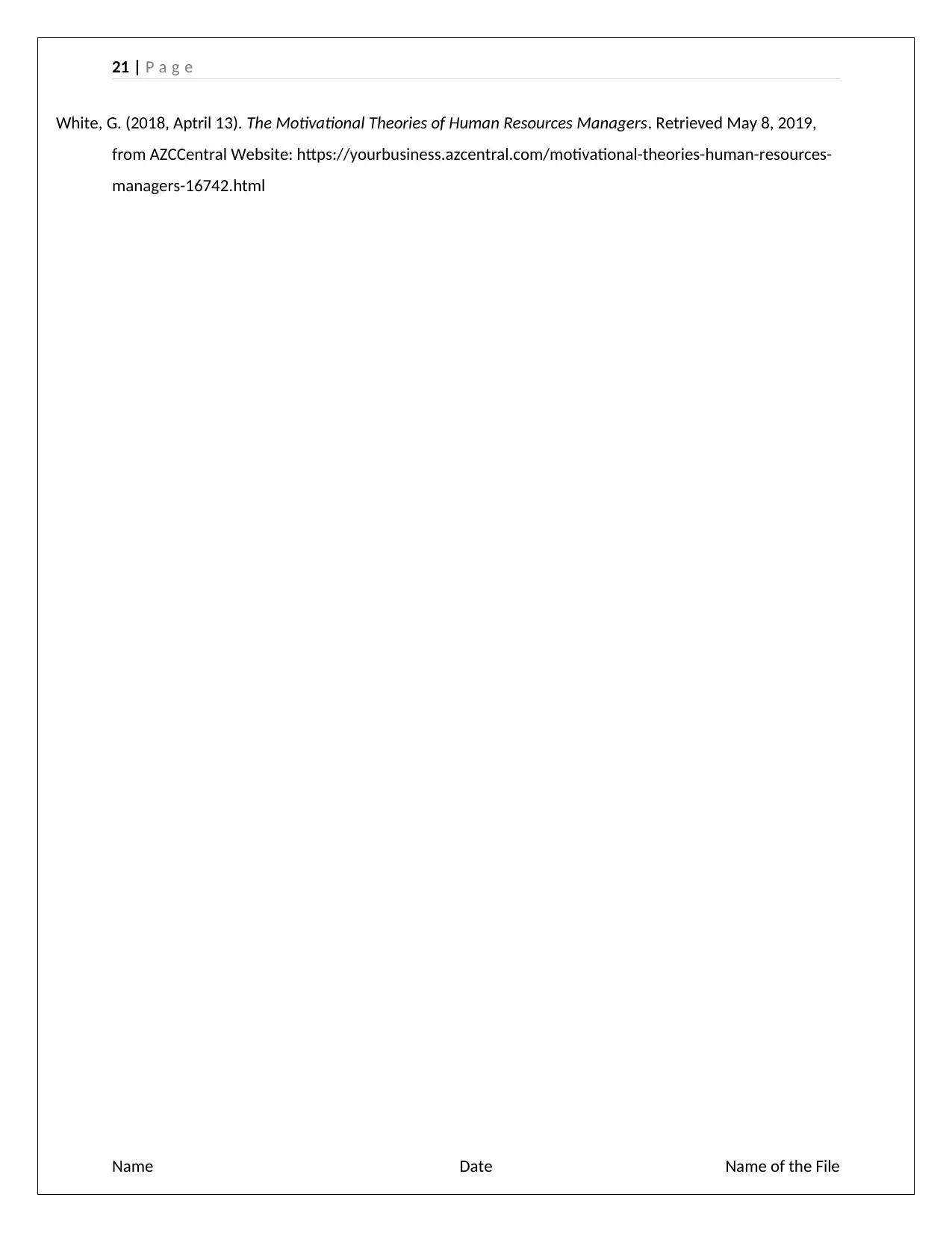
21 | P a g e
White, G. (2018, Aptril 13). The Motivational Theories of Human Resources Managers. Retrieved May 8, 2019,
from AZCCentral Website: https://yourbusiness.azcentral.com/motivational-theories-human-resources-
managers-16742.html
Name Date Name of the File
White, G. (2018, Aptril 13). The Motivational Theories of Human Resources Managers. Retrieved May 8, 2019,
from AZCCentral Website: https://yourbusiness.azcentral.com/motivational-theories-human-resources-
managers-16742.html
Name Date Name of the File
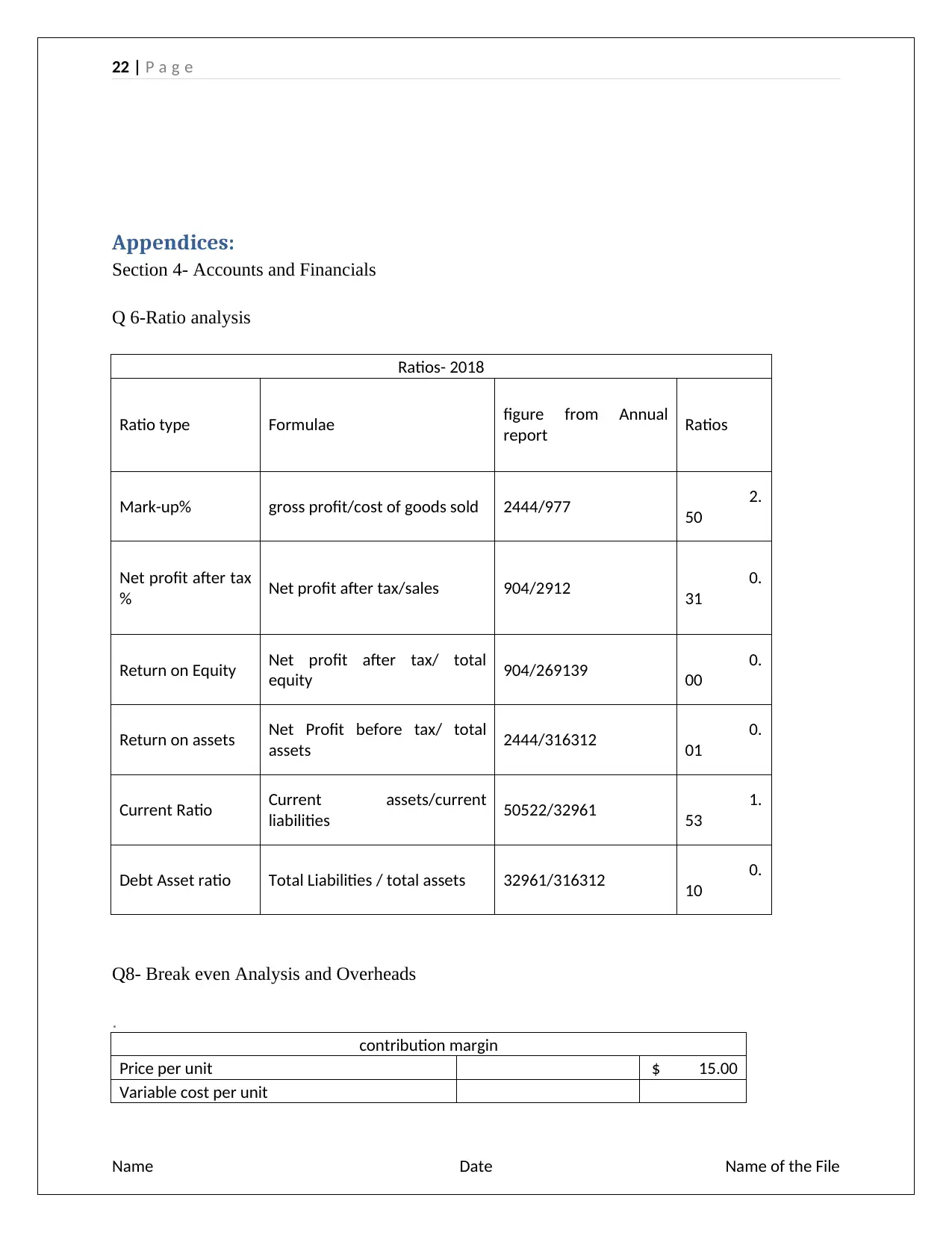
22 | P a g e
Appendices:
Section 4- Accounts and Financials
Q 6-Ratio analysis
Ratios- 2018
Ratio type Formulae figure from Annual
report Ratios
Mark-up% gross profit/cost of goods sold 2444/977 2.
50
Net profit after tax
% Net profit after tax/sales 904/2912 0.
31
Return on Equity Net profit after tax/ total
equity 904/269139 0.
00
Return on assets Net Profit before tax/ total
assets 2444/316312 0.
01
Current Ratio Current assets/current
liabilities 50522/32961 1.
53
Debt Asset ratio Total Liabilities / total assets 32961/316312 0.
10
Q8- Break even Analysis and Overheads
.
contribution margin
Price per unit $ 15.00
Variable cost per unit
Name Date Name of the File
Appendices:
Section 4- Accounts and Financials
Q 6-Ratio analysis
Ratios- 2018
Ratio type Formulae figure from Annual
report Ratios
Mark-up% gross profit/cost of goods sold 2444/977 2.
50
Net profit after tax
% Net profit after tax/sales 904/2912 0.
31
Return on Equity Net profit after tax/ total
equity 904/269139 0.
00
Return on assets Net Profit before tax/ total
assets 2444/316312 0.
01
Current Ratio Current assets/current
liabilities 50522/32961 1.
53
Debt Asset ratio Total Liabilities / total assets 32961/316312 0.
10
Q8- Break even Analysis and Overheads
.
contribution margin
Price per unit $ 15.00
Variable cost per unit
Name Date Name of the File
Secure Best Marks with AI Grader
Need help grading? Try our AI Grader for instant feedback on your assignments.
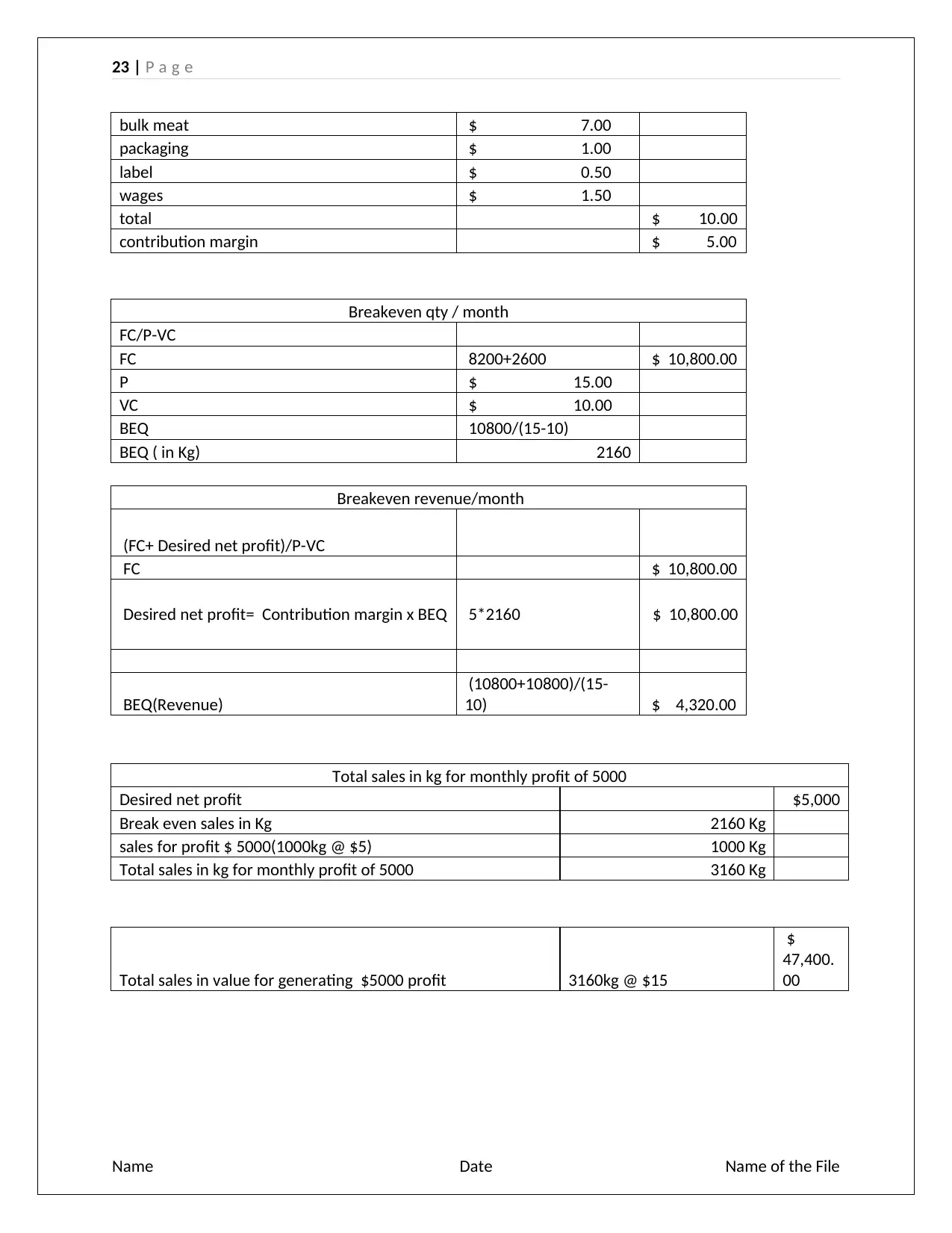
23 | P a g e
bulk meat $ 7.00
packaging $ 1.00
label $ 0.50
wages $ 1.50
total $ 10.00
contribution margin $ 5.00
Breakeven qty / month
FC/P-VC
FC 8200+2600 $ 10,800.00
P $ 15.00
VC $ 10.00
BEQ 10800/(15-10)
BEQ ( in Kg) 2160
Breakeven revenue/month
(FC+ Desired net profit)/P-VC
FC $ 10,800.00
Desired net profit= Contribution margin x BEQ 5*2160 $ 10,800.00
BEQ(Revenue)
(10800+10800)/(15-
10) $ 4,320.00
Total sales in kg for monthly profit of 5000
Desired net profit $5,000
Break even sales in Kg 2160 Kg
sales for profit $ 5000(1000kg @ $5) 1000 Kg
Total sales in kg for monthly profit of 5000 3160 Kg
Total sales in value for generating $5000 profit 3160kg @ $15
$
47,400.
00
Name Date Name of the File
bulk meat $ 7.00
packaging $ 1.00
label $ 0.50
wages $ 1.50
total $ 10.00
contribution margin $ 5.00
Breakeven qty / month
FC/P-VC
FC 8200+2600 $ 10,800.00
P $ 15.00
VC $ 10.00
BEQ 10800/(15-10)
BEQ ( in Kg) 2160
Breakeven revenue/month
(FC+ Desired net profit)/P-VC
FC $ 10,800.00
Desired net profit= Contribution margin x BEQ 5*2160 $ 10,800.00
BEQ(Revenue)
(10800+10800)/(15-
10) $ 4,320.00
Total sales in kg for monthly profit of 5000
Desired net profit $5,000
Break even sales in Kg 2160 Kg
sales for profit $ 5000(1000kg @ $5) 1000 Kg
Total sales in kg for monthly profit of 5000 3160 Kg
Total sales in value for generating $5000 profit 3160kg @ $15
$
47,400.
00
Name Date Name of the File
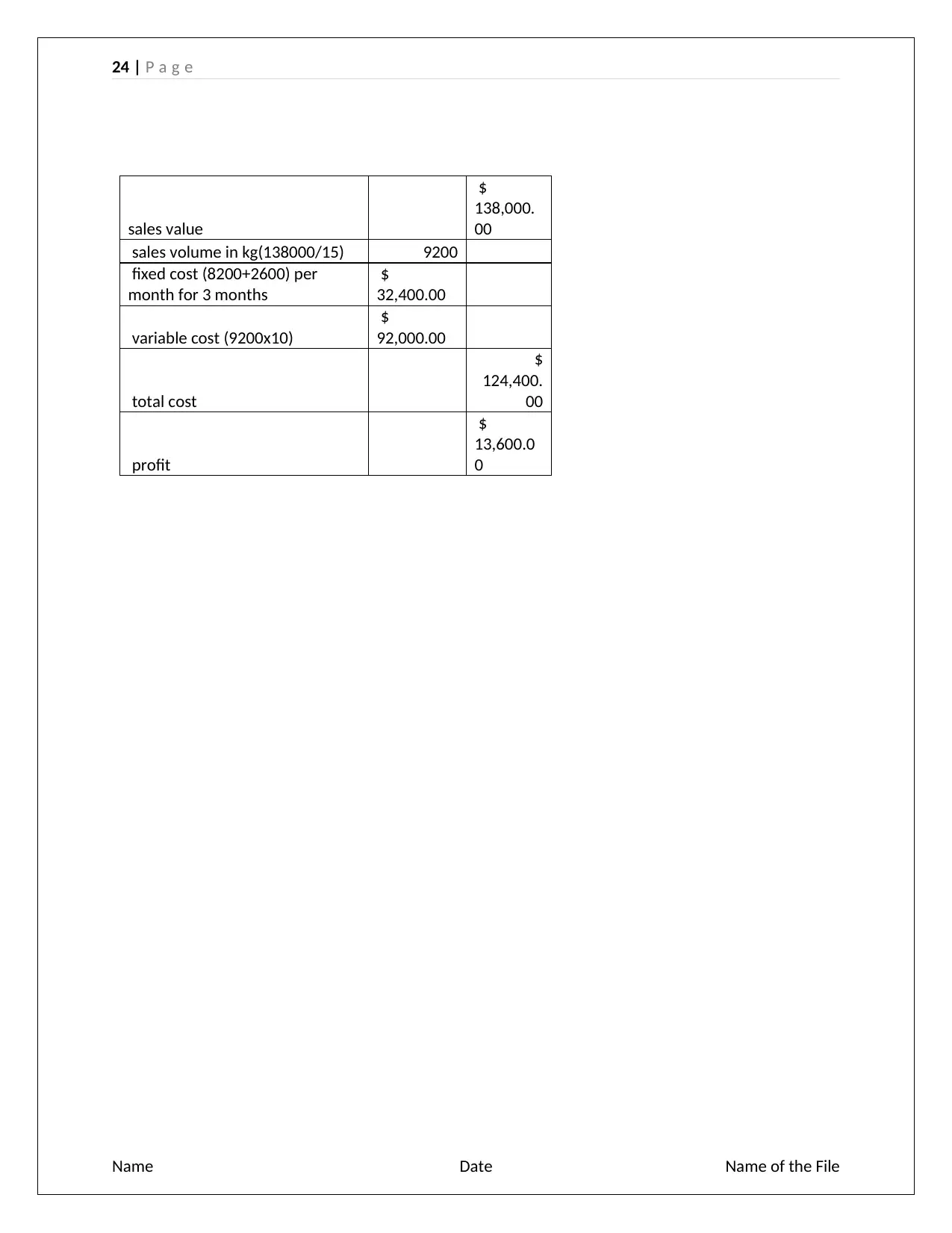
24 | P a g e
sales value
$
138,000.
00
sales volume in kg(138000/15) 9200
fixed cost (8200+2600) per
month for 3 months
$
32,400.00
variable cost (9200x10)
$
92,000.00
total cost
$
124,400.
00
profit
$
13,600.0
0
Name Date Name of the File
sales value
$
138,000.
00
sales volume in kg(138000/15) 9200
fixed cost (8200+2600) per
month for 3 months
$
32,400.00
variable cost (9200x10)
$
92,000.00
total cost
$
124,400.
00
profit
$
13,600.0
0
Name Date Name of the File
1 out of 24
Related Documents
Your All-in-One AI-Powered Toolkit for Academic Success.
+13062052269
info@desklib.com
Available 24*7 on WhatsApp / Email
![[object Object]](/_next/static/media/star-bottom.7253800d.svg)
Unlock your academic potential
© 2024 | Zucol Services PVT LTD | All rights reserved.




